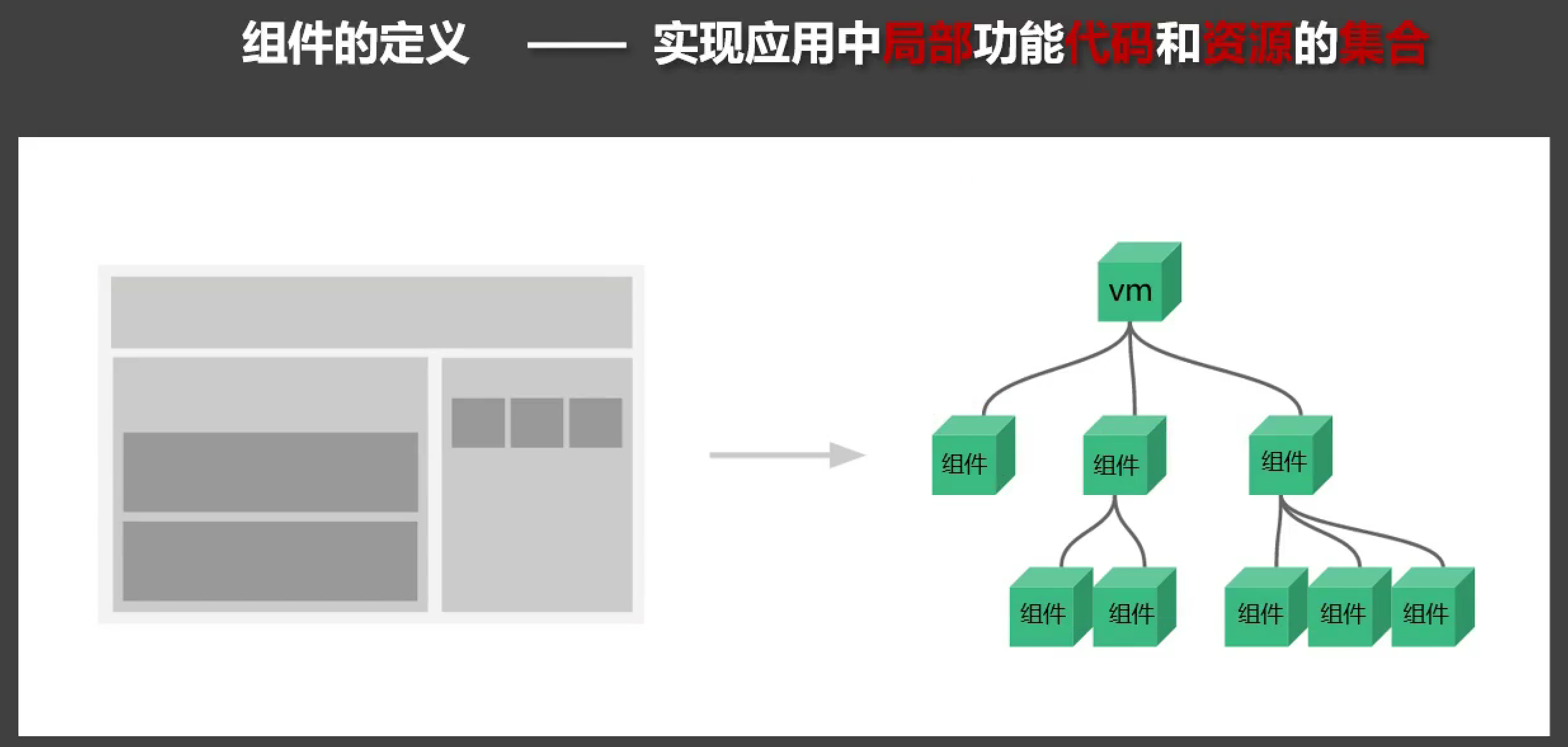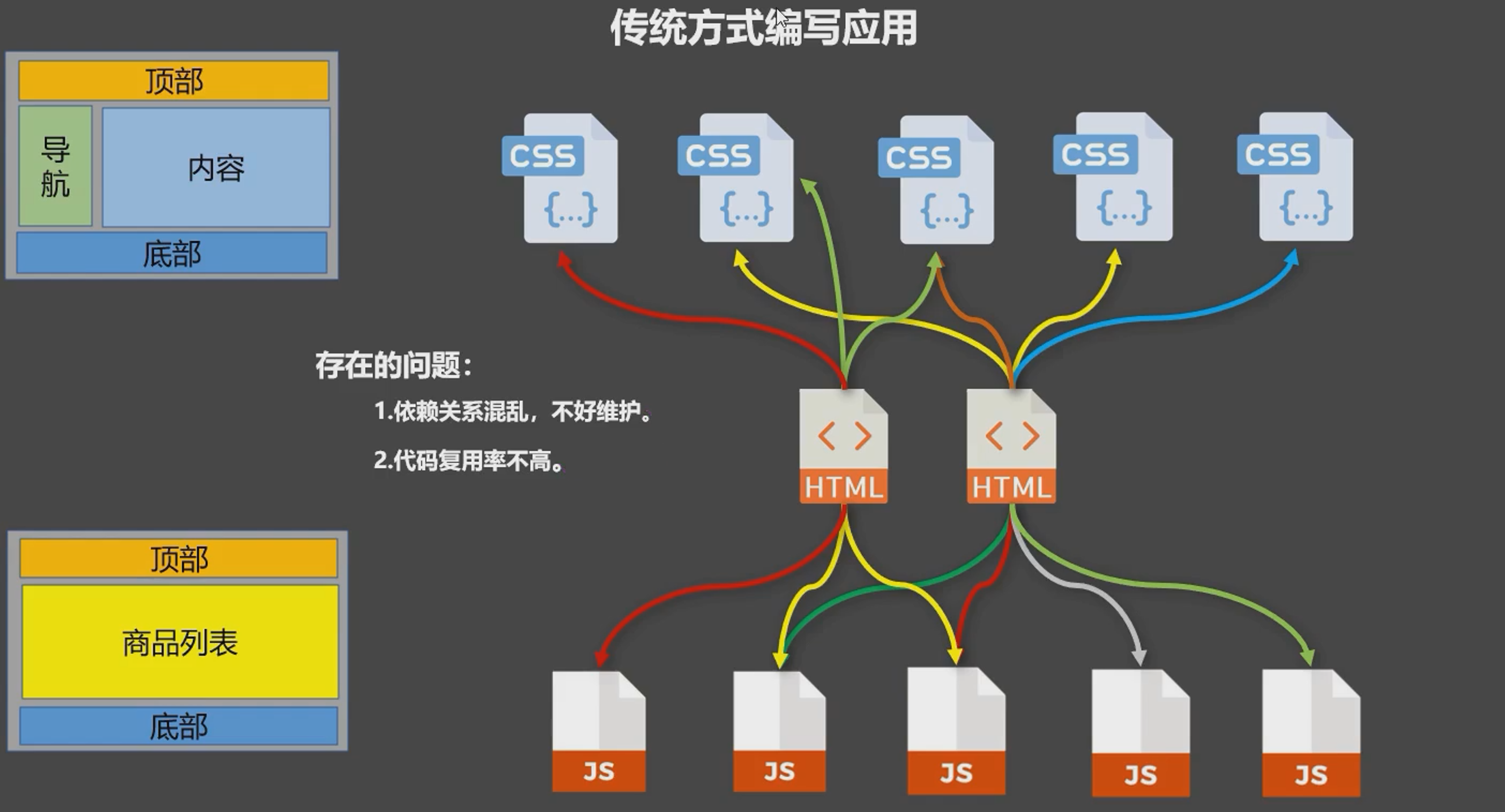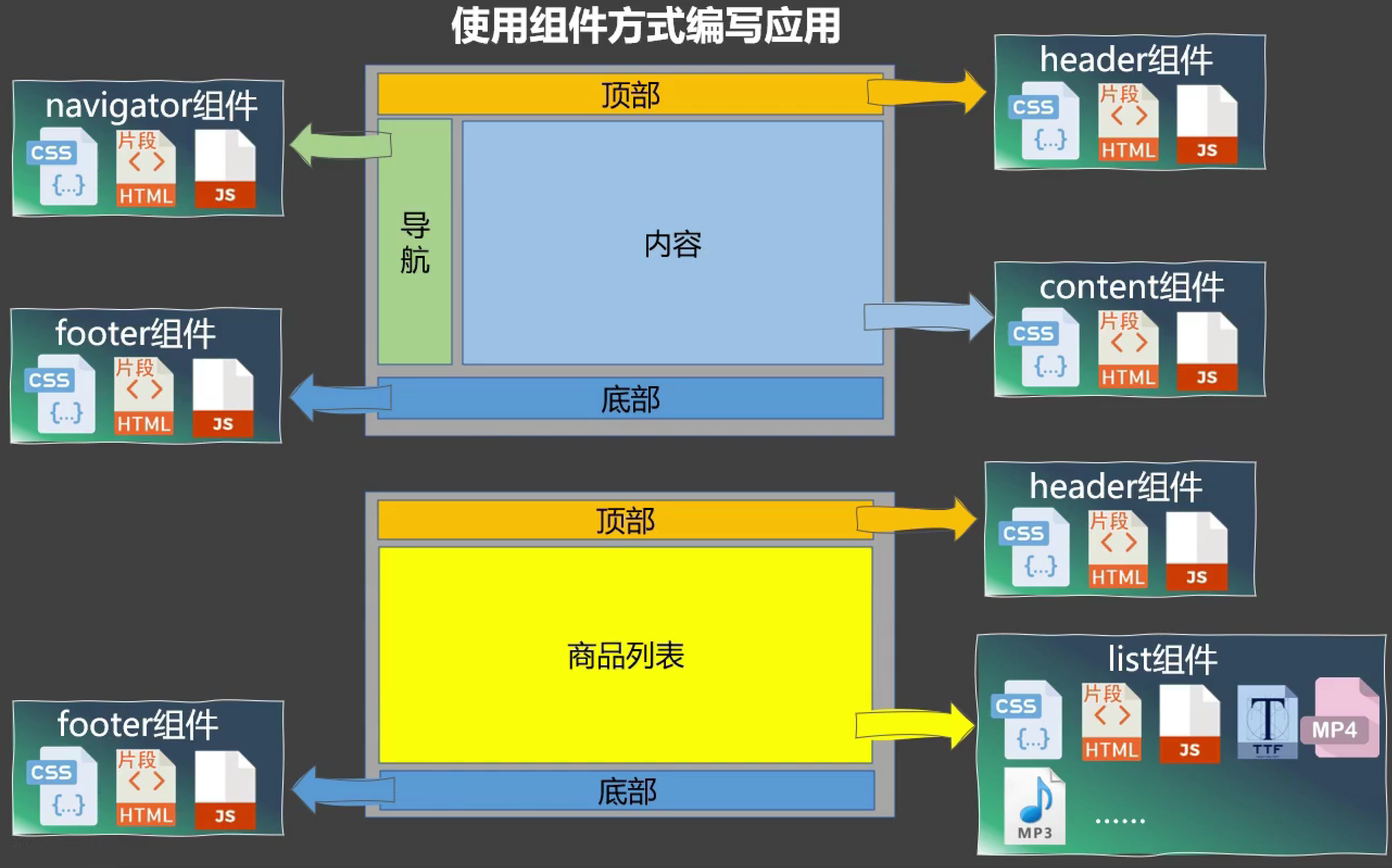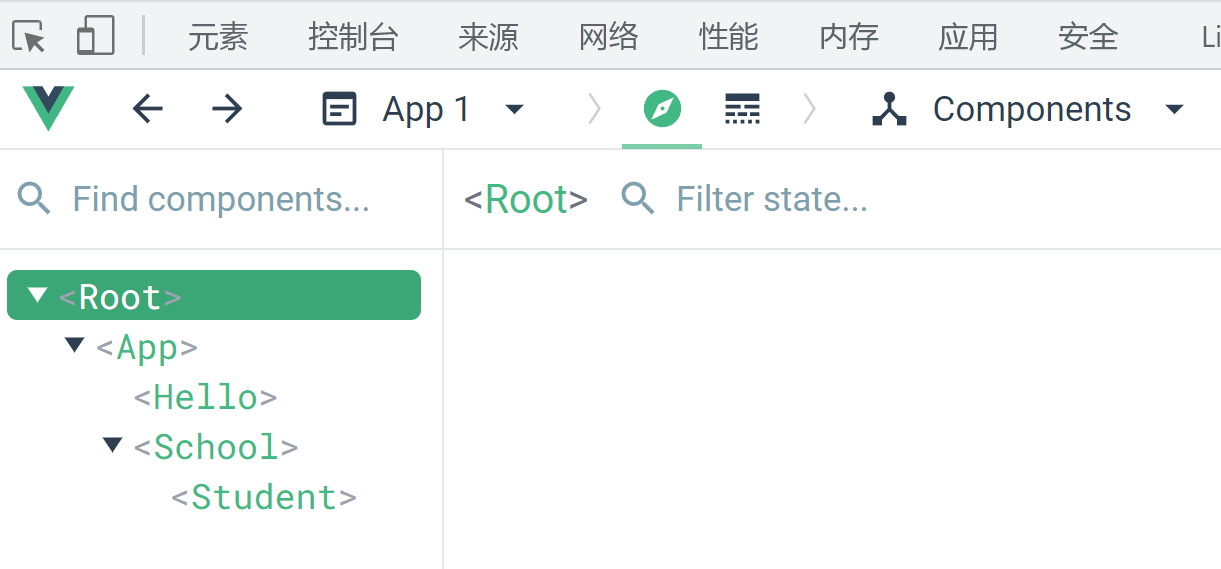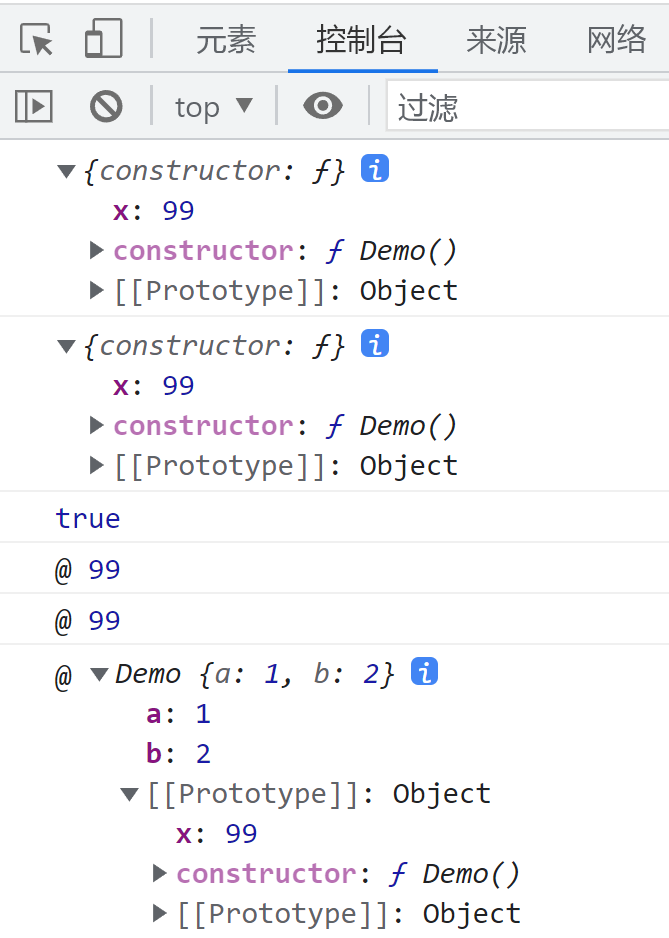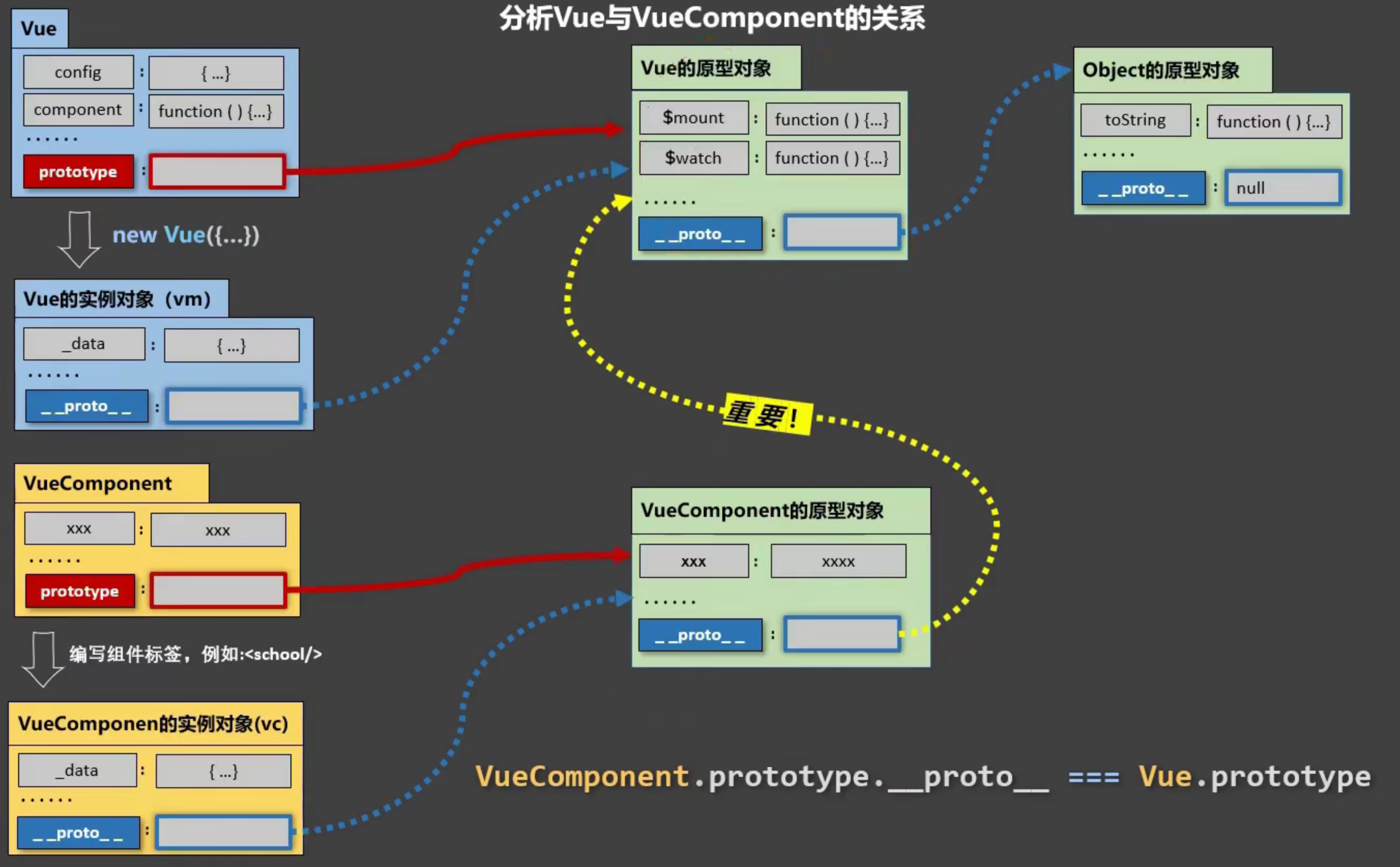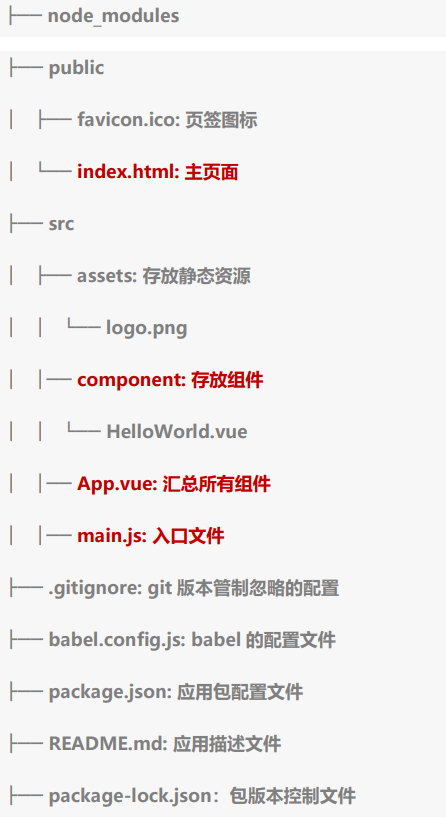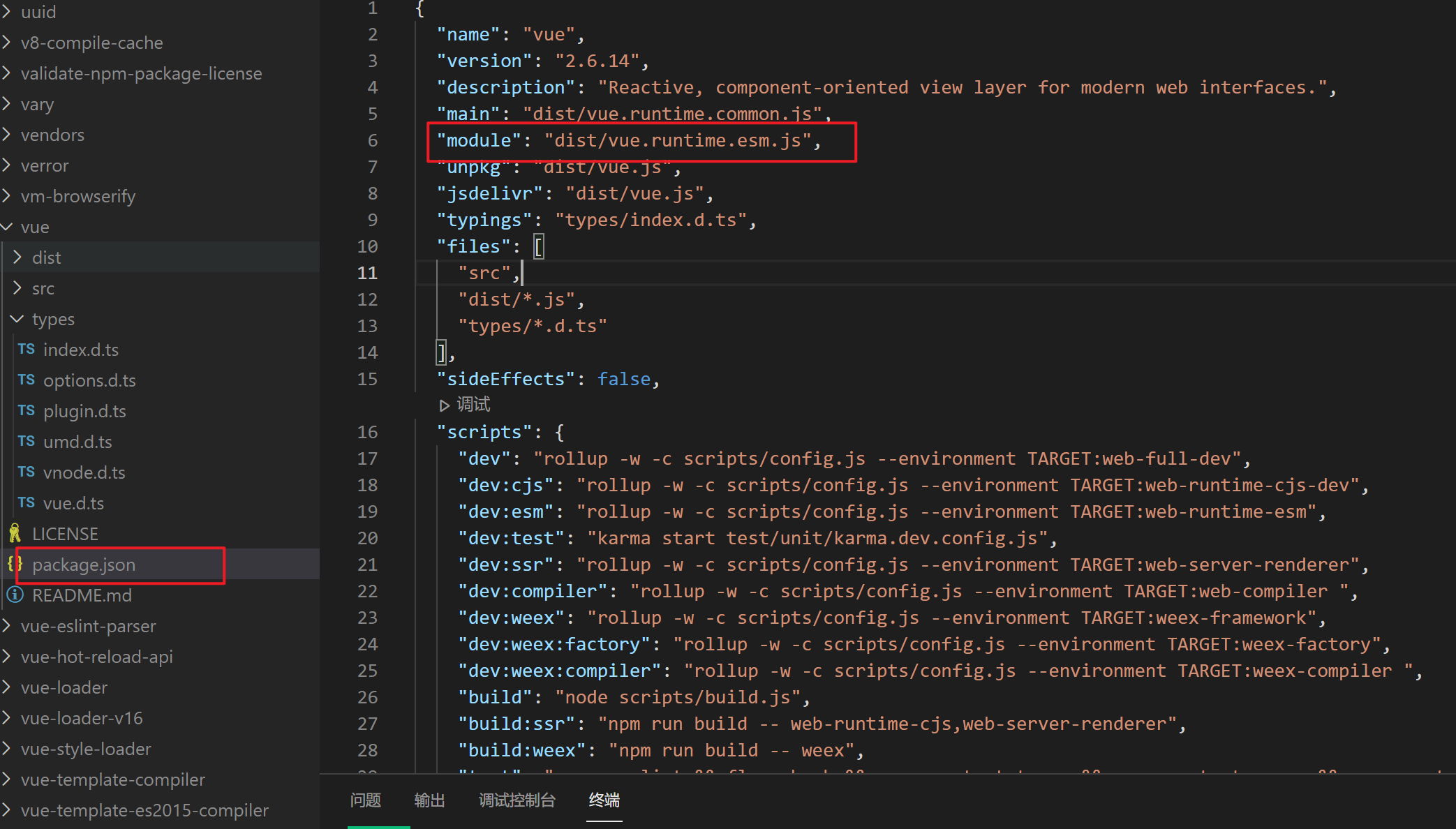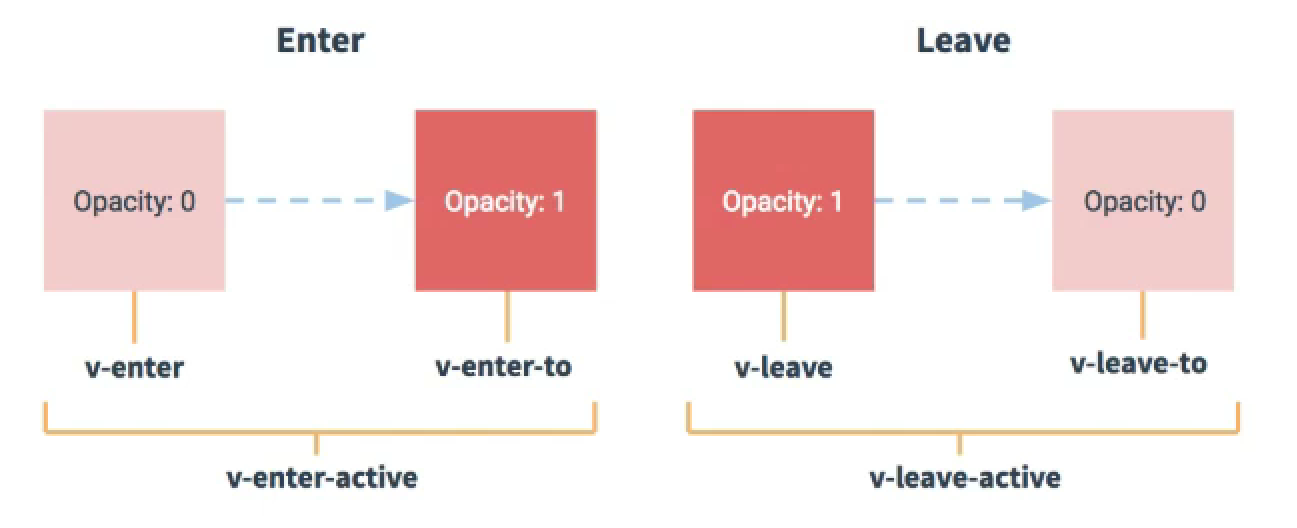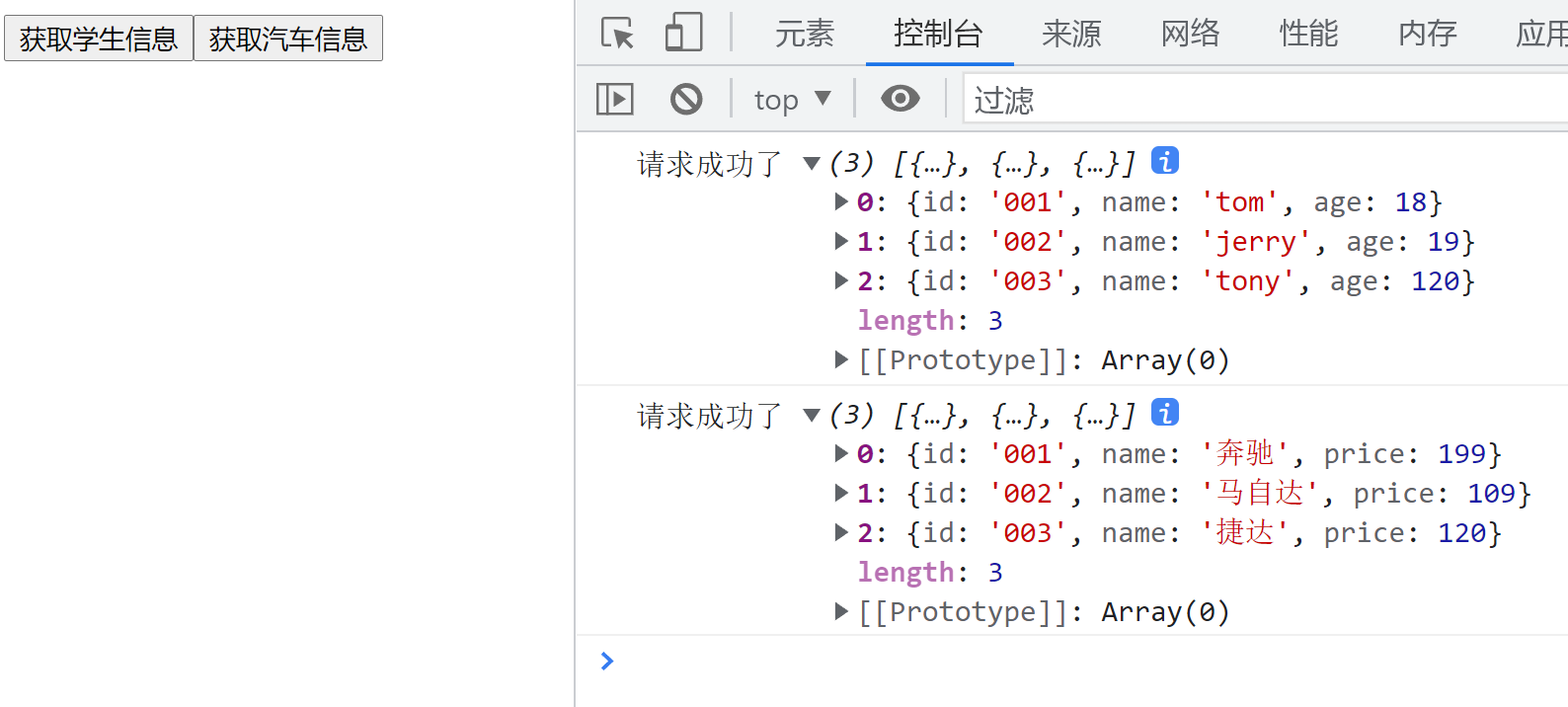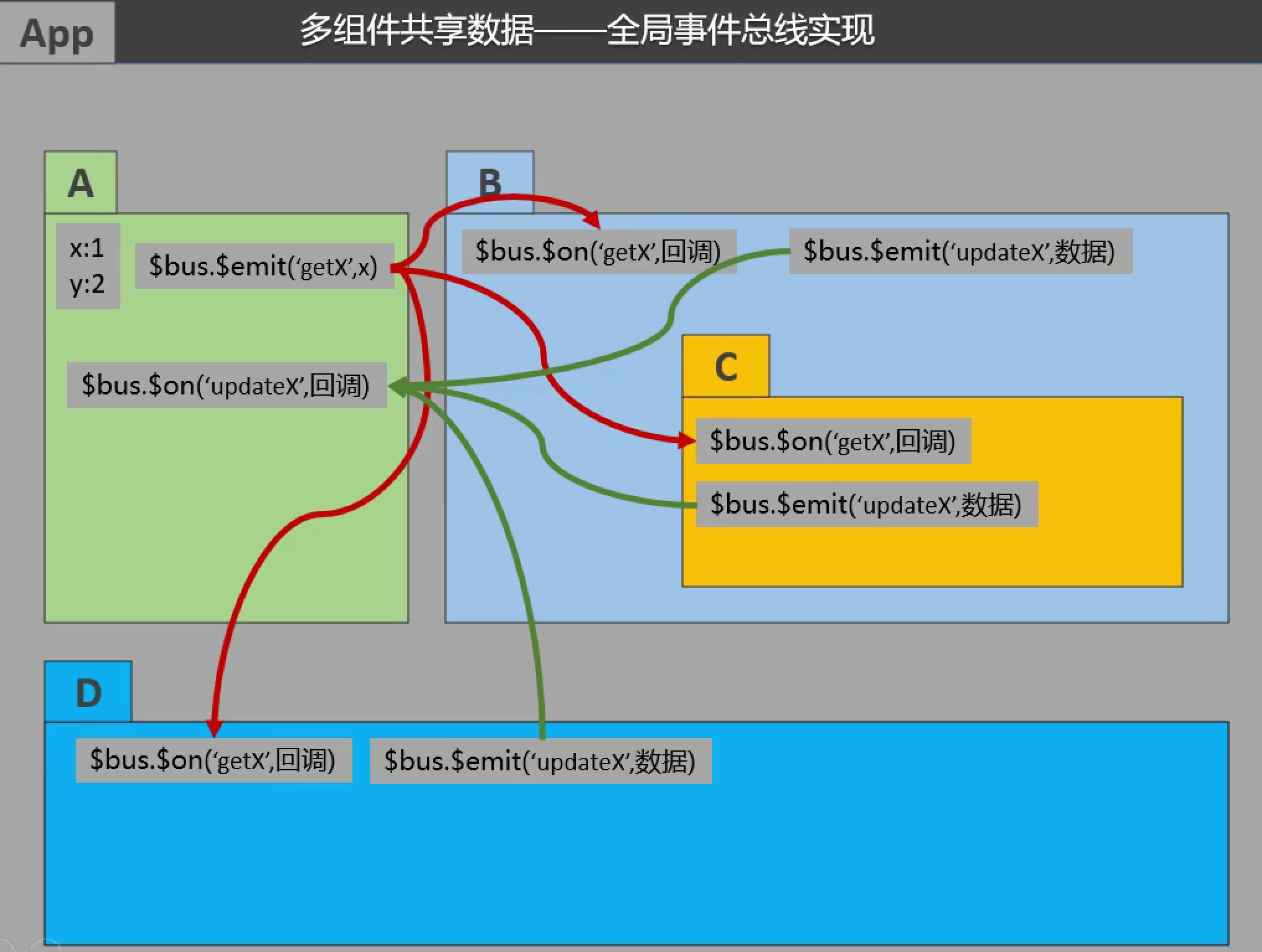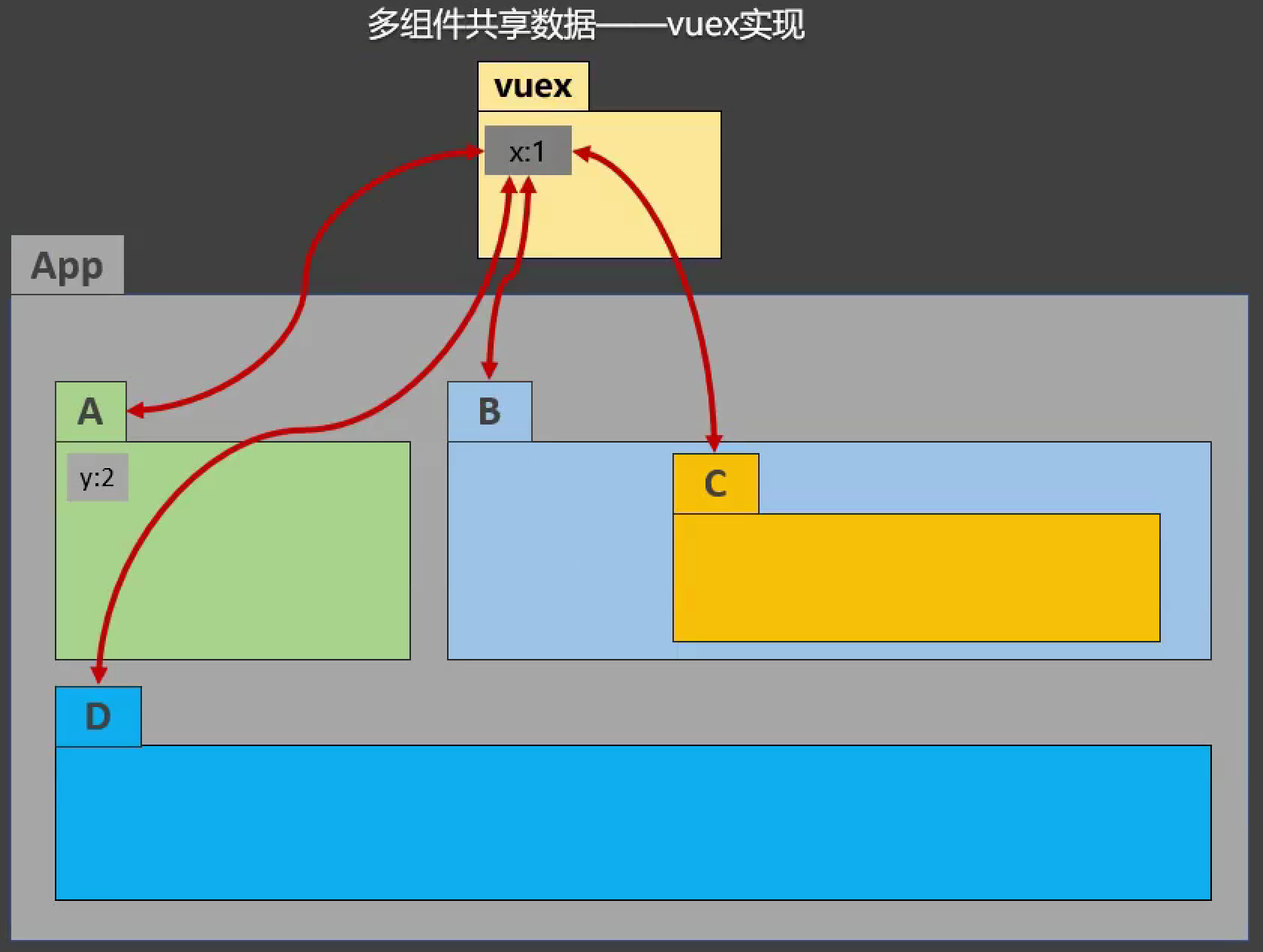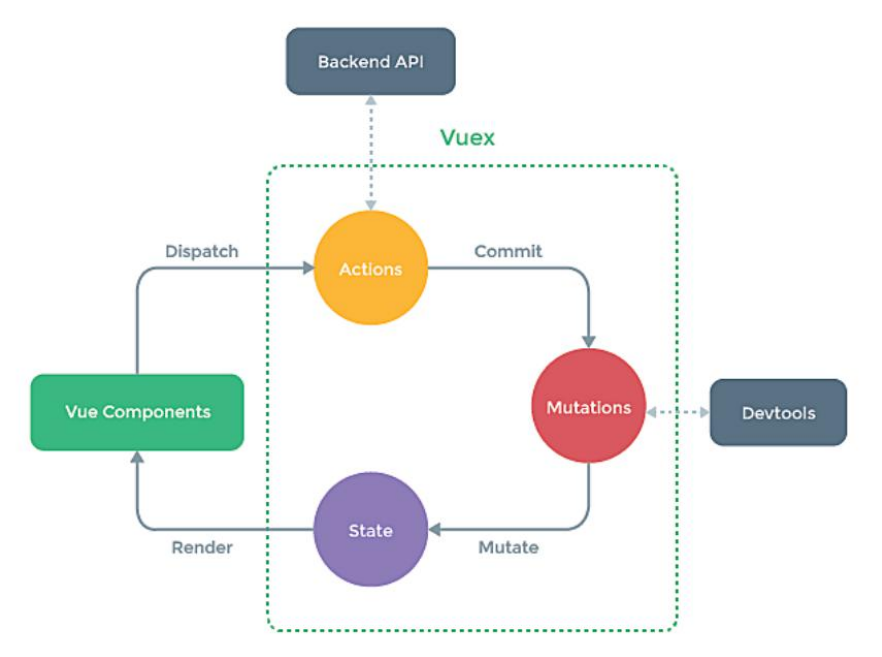Vue组件化编程
1、模块与组件、模块化与组件化
模块:向外提供特定功能的js程序,一般就是一个js文件。作用是复用js,简化js的编写,提高js运行效率。
模块化:当应用中的js都以模块来编写的,那这个应用就是一个模块化的应用。
组件:用来实现局部(特定)功能效果的代码集合(html/css/js/image等)。作用是复用编码,简化项目编码,提高运行效率。
![]()
组件化:当应用中的功能都是多组件的方式来编写的,那这个应用就是一个组件化的应用。
传统方式编写应用:
![]()
使用组件方式编写应用:
![]()
2、非单文件组件
定义是一个文件中包含n(n>1)个组件。Vue中使用组件的三大步骤:
- ①定义组件(创建组件)。
- ②注册组件。
- ③使用组件(写组件标签)。
1
2
3
4
5
6
7
8
9
10
11
12
13
14
15
16
17
18
19
20
21
22
23
24
25
26
27
28
29
30
31
32
33
34
35
36
37
38
39
40
41
42
43
44
45
46
47
48
49
50
51
52
53
54
55
56
57
58
59
60
61
62
63
64
65
66
67
68
69
70
71
72
73
74
75
76
77
78
79
80
81
82
83
84
85
86
87
88
89
90
91
92
93
94
95
96
97
98
99
100
101
102
103
104
105
106
107
108
109
110
111
112
113
114
115
116
117
118
<html>
<head>
<meta charset="UTF-8" />
<title>基本使用</title>
<script type="text/javascript" src="../js/vue.js"></script>
</head>
<body>
<!--
一、如何定义一个组件?
使用Vue.extend(options)创建,其中options和new Vue(options)时传入的那个options几乎一样,但也有点区别;
区别如下:
1.el不要写,为什么? ——— 最终所有的组件都要经过一个vm的管理,由vm中的el决定服务哪个容器。
2.data必须写成函数,为什么? ———— 避免组件被复用时,数据存在引用关系。
备注:使用template可以配置组件结构。
二、如何注册组件?
1.局部注册:靠new Vue的时候传入components选项
2.全局注册:靠Vue.component('组件名',组件)
三、编写组件标签:
<school></school>
-->
<!-- 准备好一个容器-->
<div id="root">
<hello></hello>
<hr>
<h1>{{msg}}</h1>
<hr>
<!-- 第三步:编写组件标签 -->
<school></school>
<hr>
<!-- 第三步:编写组件标签 -->
<student></student>
</div>
<div id="root2">
<hello></hello>
</div>
</body>
<script type="text/javascript">
Vue.config.productionTip = false
//第一步:创建school组件
const school = Vue.extend({
template:`
<div class="demo">
<h2>学校名称:{{schoolName}}</h2>
<h2>学校地址:{{address}}</h2>
<button @click="showName">点我提示学校名</button>
</div>
`,
// el:'#root', //组件定义时,一定不要写el配置项,因为最终所有的组件都要被一个vm管理,由vm决定服务于哪个容器。
data(){
return {
schoolName:'gzmtu',
address:'guangzhou'
}
},
methods: {
showName(){
alert(this.schoolName)
}
},
})
//第一步:创建student组件
const student = Vue.extend({
template:`
<div>
<h2>学生姓名:{{studentName}}</h2>
<h2>学生年龄:{{age}}</h2>
</div>
`,
data(){
return {
studentName:'张三',
age:18
}
}
})
//第一步:创建hello组件
const hello = Vue.extend({
template:`
<div>
<h2>你好啊!{{name}}</h2>
</div>
`,
data(){
return {
name:'Tom'
}
}
})
//第二步:全局注册组件
Vue.component('hello',hello)
//创建vm
new Vue({
el:'#root',
data:{
msg:'你好啊!'
},
//第二步:注册组件(局部注册)
components:{
school,
student
}
})
new Vue({
el:'#root2',
})
</script>
</html>编写组件时的几个注意点:
1
2
3
4
5
6
7
8
9
10
11
12
13
14
15
16
17
18
19
20
21
22
23
24
25
26
27
28
29
30
31
32
33
34
35
36
37
38
39
40
41
42
43
44
45
46
47
48
49
50
51
52
53
54
55
56
57
58
59
60
61
62
63
64
65
66
67
<html>
<head>
<meta charset="UTF-8" />
<title>几个注意点</title>
<script type="text/javascript" src="../js/vue.js"></script>
</head>
<body>
<!--
几个注意点:
1.关于组件名:
一个单词组成:
第一种写法(首字母小写):school
第二种写法(首字母大写):School
多个单词组成:
第一种写法(kebab-case命名):my-school
第二种写法(CamelCase命名):MySchool (需要Vue脚手架支持)
备注:
(1).组件名尽可能回避HTML中已有的元素名称,例如:h2、H2都不行。
(2).可以使用name配置项指定组件在开发者工具中呈现的名字。
2.关于组件标签:
第一种写法:<school></school>
第二种写法:<school/>
备注:不用使用脚手架时,<school/>会导致后续组件不能渲染。
3.一个简写方式:
const school = Vue.extend(options) 可简写为:const school = options
-->
<!-- 准备好一个容器-->
<div id="root">
<h1>{{msg}}</h1>
<school></school>
</div>
</body>
<script type="text/javascript">
Vue.config.productionTip = false
//定义组件
const s = Vue.extend({
name:'gzmtu',
template:`
<div>
<h2>学校名称:{{name}}</h2>
<h2>学校地址:{{address}}</h2>
</div>
`,
data(){
return {
name:'gzmtu',
address:'guangzhou'
}
}
})
new Vue({
el:'#root',
data:{
msg:'欢迎学习Vue!'
},
components:{
school:s
}
})
</script>
</html>组件的嵌套:
1
2
3
4
5
6
7
8
9
10
11
12
13
14
15
16
17
18
19
20
21
22
23
24
25
26
27
28
29
30
31
32
33
34
35
36
37
38
39
40
41
42
43
44
45
46
47
48
49
50
51
52
53
54
55
56
57
58
59
60
61
62
63
64
65
66
67
68
69
70
71
72
73
74
75
76
77
78
79
80
81
82
83
84
85
86
87
88
89
90
<html>
<head>
<meta charset="UTF-8" />
<title>组件的嵌套</title>
<!-- 引入Vue -->
<script type="text/javascript" src="../js/vue.js"></script>
</head>
<body>
<!-- 准备好一个容器-->
<div id="root">
</div>
</body>
<script type="text/javascript">
{{name}}</h2>
{{age}}</h2>
{{name}}</h2>
{{address}}</h2>
{{msg}}</h1>`,
</script>
</html>![]()
实际上每个组件都是VueComponent类型的,Vue解析时会帮我们创建该组件的实例对象。
1
2
3
4
5
6
7
8
9
10
11
12
13
14
15
16
17
18
19
20
21
22
23
24
25
26
27
28
29
30
31
32
33
34
35
36
37
38
39
40
41
42
43
44
45
46
47
48
49
50
51
52
53
54
55
56
57
58
59
60
61
62
63
64
65
66
67
68
69
70
71
72
73
74
75
76
77
78
79
80
81
82
83
84
85
86
87
88
89
90
<html>
<head>
<meta charset="UTF-8" />
<title>VueComponent</title>
<script type="text/javascript" src="../js/vue.js"></script>
</head>
<body>
<!--
关于VueComponent:
1.school组件本质是一个名为VueComponent的构造函数,且不是程序员定义的,是Vue.extend生成的。
2.我们只需要写<school/>或<school></school>,Vue解析时会帮我们创建school组件的实例对象,
即Vue帮我们执行的:new VueComponent(options)。
3.特别注意:每次调用Vue.extend,返回的都是一个全新的VueComponent!!!!
4.关于this指向:
(1).组件配置中:
data函数、methods中的函数、watch中的函数、computed中的函数 它们的this均是【VueComponent实例对象】。
(2).new Vue(options)配置中:
data函数、methods中的函数、watch中的函数、computed中的函数 它们的this均是【Vue实例对象】。
5.VueComponent的实例对象,以后简称vc(也可称之为:组件实例对象)。
Vue的实例对象,以后简称vm。
-->
<!-- 准备好一个容器-->
<div id="root">
<school></school>
<hello></hello>
</div>
</body>
<script type="text/javascript">
Vue.config.productionTip = false
//定义school组件
const school = Vue.extend({
name:'school',
template:`
<div>
<h2>学校名称:{{name}}</h2>
<h2>学校地址:{{address}}</h2>
<button @click="showName">点我提示学校名</button>
</div>
`,
data(){
return {
name:'gzmtu',
address:'guangzhou'
}
},
methods: {
showName(){
console.log('showName',this)
}
},
})
const test = Vue.extend({
template:`<span>gzmtu</span>`
})
//定义hello组件
const hello = Vue.extend({
template:`
<div>
<h2>{{msg}}</h2>
<test></test>
</div>
`,
data(){
return {
msg:'你好啊!'
}
},
components:{test}
})
// console.log('@',school)
// console.log('#',hello)
//创建vm
const vm = new Vue({
el:'#root',
components:{school,hello}
})
</script>
</html>vm实例管理着许多vc实例。
![]()
一个重要的内置关系:VueComponent.prototype.__proto__===Vue.prototype。因为要让组件实例对象(vc)可以访问到Vue原型上的属性、方法。
1
2
3
4
5
6
7
8
9
10
11
12
13
14
15
16
17
18
19
20
21
22
23
24<script type="text/javascript">
//定义一个构造函数
function Demo(){
this.a = 1
this.b = 2
}
//创建一个Demo的实例对象
const d = new Demo()
console.log(Demo.prototype) //显示原型属性
console.log(d.__proto__) //隐式原型属性
console.log(Demo.prototype === d.__proto__)
//程序员通过显示原型属性操作原型对象,追加一个x属性,值为99
Demo.prototype.x = 99
console.log('@',d.__proto__.x)
console.log('@',d.x)
console.log('@',d)
</script>![1639838747956]()
1
2
3
4
5
6
7
8
9
10
11
12
13
14
15
16
17
18
19
20
21
22
23
24
25
26
27
28
29
30
31
32
33
34
35
36
37
38
39
40
41
42
43
44
45
46
47
48
49
50
51
52
53
54
55
56
57
58
<html>
<head>
<meta charset="UTF-8" />
<title>一个重要的内置关系</title>
<!-- 引入Vue -->
<script type="text/javascript" src="../js/vue.js"></script>
</head>
<body>
<!--
1.一个重要的内置关系:VueComponent.prototype.__proto__ === Vue.prototype
2.为什么要有这个关系:让组件实例对象(vc)可以访问到Vue原型上的属性、方法。
-->
<!-- 准备好一个容器-->
<div id="root">
<school></school>
</div>
</body>
<script type="text/javascript">
Vue.config.productionTip = false
Vue.prototype.x = 99
//定义school组件
const school = Vue.extend({
name:'school',
template:`
<div>
<h2>学校名称:{{name}}</h2>
<h2>学校地址:{{address}}</h2>
<button @click="showX">点我输出x</button>
</div>
`,
data(){
return {
name:'gzmtu',
address:'guangzhou'
}
},
methods: {
showX(){
console.log(this.x)
}
},
})
//创建一个vm
const vm = new Vue({
el:'#root',
data:{
msg:'你好'
},
components:{school}
})
console.log(school.prototype.__proto__ === Vue.prototype)//true
</script>
</html>![]()
3、单文件组件
一个.vue文件的组成有3个部分:
模板页面:
1
2
3<template>
页面模板
</template>JS模块对象:
1
2
3
4
5
6
7
8
9
10<script>
export default {
data(){
return {
}
},
methods: {
}
}
</script>样式:
1
2
3<style>
样式定义
</style>
实际案例:
School.vue:
1
2
3
4
5
6
7
8
9
10
11
12
13
14
15
16
17
18
19
20
21
22
23
24
25
26
27
28
29
30<template>
<div class="demo">
<h2>学校名称:{{name}}</h2>
<h2>学校地址:{{address}}</h2>
<button @click="showName">点我提示学校名</button>
</div>
</template>
<script>
export default {
name:'School',
data(){
return {
name:'gzmtu',
address:'guangzhou'
}
},
methods: {
showName(){
alert(this.name)
}
},
}
</script>
<style>
.demo{
background-color: orange;
}
</style>Student.vue:
1
2
3
4
5
6
7
8
9
10
11
12
13
14
15
16
17
18<template>
<div>
<h2>学生姓名:{{name}}</h2>
<h2>学生年龄:{{age}}</h2>
</div>
</template>
<script>
export default {
name:'Student',
data(){
return {
name:'张三',
age:18
}
}
}
</script>App.vue:
1
2
3
4
5
6
7
8
9
10
11
12
13
14
15
16
17
18
19
20<template>
<div>
<School></School>
<Student></Student>
</div>
</template>
<script>
//引入组件
import School from './School.vue'
import Student from './Student.vue'
export default {
name:'App',
components:{
School,
Student
}
}
</script>main.js:
1
2
3
4
5
6
7import App from './App.vue'
new Vue({
el:'#root',
template:`<App></App>`,
components:{App},
})index.html:
1
2
3
4
5
6
7
8
9
10
11
12
13
<html>
<head>
<meta charset="UTF-8" />
<title>练习一下单文件组件的语法</title>
</head>
<body>
<!-- 准备一个容器 -->
<div id="root"></div>
<script type="text/javascript" src="../js/vue.js"></script>
<script type="text/javascript" src="./main.js"></script>
</body>
</html>
4、使用Vue脚手架
Vue脚手架是Vue官方提供的标准化开发工具(开发平台)。
全局安装@vue/cli:
1
npm install -g @vue/cli
切换到你要创建项目的目录,然后使用命令创建项目:
1
vue create vue_test
进入项目目录,启动项目。
1
npm run serve
-
![1639895836524]()
4.1 模板项目的结构
整体模板结构如下:
![]()
main.js是整个项目的入口文件。
1
2
3
4
5
6
7
8
9
10
11
12
13
14
15
16
17
18
19
20
21// 引入Vue
import Vue from 'vue'
// 引入App组件,它是所有组件的父组件
import App from './App.vue'
// 关闭Vue的生产提示
Vue.config.productionTip = false
/*
关于不同版本的Vue:
1.vue.js与vue.runtime.xxx.js的区别:
(1).vue.js是完整版的Vue,包含:核心功能+模板解析器。
(2).vue.runtime.xxx.js是运行版的Vue,只包含:核心功能;没有模板解析器。
2.因为vue.runtime.xxx.js没有模板解析器,所以不能使用template配置项,需要使用
render函数接收到的createElement函数去指定具体内容。
*/
// 创建Vue的实例对象vm
new Vue({
// 将App组件放进容器中
render: h => h(App),
}).$mount('#app')import Vue from 'vue'引入的是一个残缺版的vue(不能解析template标签)。![]()
由于引入的是一个残缺版的vue(不能解析template标签),需要由render函数帮我们渲染页面。
1
2
3
4
5
6
7
8
9
10
11import Vue from 'vue' // 引入残缺版vue
//import Vue from 'vue/dist/vue' // 引入完整版vue
// 创建Vue的实例对象vm
new Vue({
// 将App组件放进容器中
//render: h => h(App),
// 传入createElement函数
render(createElement) {
return createElement('h1','你好啊')
}
}).$mount('#app')
public/index.html文件是主页面。
1
2
3
4
5
6
7
8
9
10
11
12
13
14
15
16
17
18
19
20
21
22
23
<html lang="">
<head>
<meta charset="utf-8">
<!-- 针对IE浏览器的一个特殊配置,含义是让IE浏览器以最高的渲染级别渲染页面 -->
<meta http-equiv="X-UA-Compatible" content="IE=edge">
<!-- 开启移动端的理想视口 -->
<meta name="viewport" content="width=device-width,initial-scale=1.0">
<!-- 配置页签图标,BASE_URL即public所在路径 -->
<link rel="icon" href="<%= BASE_URL %>favicon.ico">
<!-- 配置网页标题,从package.json文件读取内容 -->
<title><%= htmlWebpackPlugin.options.title %></title>
</head>
<body>
<!-- 当浏览器不支持js时noscript中的元素就会被渲染 -->
<noscript>
<strong>We're sorry but <%= htmlWebpackPlugin.options.title %> doesn't work properly without JavaScript enabled. Please enable it to continue.</strong>
</noscript>
<!-- 容器 -->
<div id="app"></div>
<!-- built files will be auto injected -->
</body>
</html>
修改默认配置:
Vue脚手架隐藏了所有webpack相关的配置,若想查看具体的webpack配置,需运行以下命令:
1
vue inspect > output.js
若想修改配置,参考官网流程如下(https://cli.vuejs.org/zh/config/#vue-config-js):
![]()
例如关闭语法检查:
1
2
3module.exports = {
lintOnSave: false // 关闭语法检查
}
4.2 ref与props
ref
被用来给元素或子组件注册引用信息(id的替代者)。
应用在html标签上获取的是真实DOM元素,应用在组件标签上是组件实例对象(vc)。
使用方式:
- 打标识:
<h1 ref="xxx">.....</h1>或<School ref="xxx"></School> - 获取:
this.$refs.xxx
- 打标识:
案例:
School.vue:
1
2
3
4
5
6
7
8
9
10
11
12
13
14
15
16
17
18
19
20
21
22
23
24<template>
<div class="school">
<h2>学校名称:{{name}}</h2>
<h2>学校地址:{{address}}</h2>
</div>
</template>
<script>
export default {
name:'School',
data() {
return {
name:'gzmtu',
address:'guangzhou'
}
},
}
</script>
<style>
.school{
background-color: gray;
}
</style>App.vue:
1
2
3
4
5
6
7
8
9
10
11
12
13
14
15
16
17
18
19
20
21
22
23
24
25
26
27
28<template>
<div>
<h1 v-text="msg" ref="title"></h1>
<button ref="btn" @click="showDOM">点我输出上方的DOM元素</button>
<School ref="sch"/>
</div>
</template>
<script>
//引入School组件
import School from './components/School'
export default {
name:'App',
components:{School},
data() {
return {
msg:'欢迎学习Vue!'
}
},
methods: {
showDOM(){
console.log(this.$refs.title) //真实DOM元素
console.log(this.$refs.btn) //真实DOM元素
console.log(this.$refs.sch) //School组件的实例对象(vc)
}
},
}
</script>
![]()
props
功能:让组件接收外部传过来的数据。
传递数据:
<Demo name="xxx"/>。接收数据:
第一种方式(只接收):
props:['name']第二种方式(限制类型):
props:{name:String}第三种方式(限制类型、限制必要性、指定默认值):
1
2
3
4
5
6
7props:{
name:{
type:String, //类型
required:true, //必要性
default:'老王' //默认值
}
}
props是只读的,Vue底层会监测你对props的修改,如果进行了修改,就会发出警告,若业务需求确实需要修改,那么请复制props的内容到data中一份,然后去修改data中的数据。
案例:
Student.vue:
1
2
3
4
5
6
7
8
9
10
11
12
13
14
15
16
17
18
19
20
21
22
23
24
25
26
27
28
29
30
31
32
33
34
35
36
37
38
39
40
41
42
43
44
45
46
47
48
49
50
51
52<template>
<div>
<h1>{{msg}}</h1>
<h2>学生姓名:{{name}}</h2>
<h2>学生性别:{{sex}}</h2>
<h2>学生年龄:{{myAge+1}}</h2>
<button @click="updateAge">尝试修改收到的年龄</button>
</div>
</template>
<script>
export default {
name:'Student',
data() {
console.log(this)
return {
msg:'gzmtu',
myAge:this.age
}
},
methods: {
updateAge(){
this.myAge++
}
},
//简单声明接收
// props:['name','age','sex']
//接收的同时对数据进行类型限制
/* props:{
name:String,
age:Number,
sex:String
} */
//接收的同时对数据:进行类型限制+默认值的指定+必要性的限制
props:{
name:{
type:String, //name的类型是字符串
required:true, //name是必要的
},
age:{
type:Number,
default:99 //默认值
},
sex:{
type:String,
required:true
}
}
}
</script>App.vue:
1
2
3
4
5
6
7
8
9
10
11
12
13
14<template>
<div>
<Student name="李四" sex="女" :age="18"/>
</div>
</template>
<script>
import Student from './components/Student'
export default {
name:'App',
components:{Student}
}
</script>
4.3 混入
功能:可以把多个组件共用的配置提取成一个混入对象。
使用方式:
第一步,定义混合:
1
2
3
4
5
6
7// 如果属性发生冲突,则以vue文件里的属性值为准
// 如果生命周期方法发生冲突,则合并,即都有,且vue文件里生命周期的方法后执行
{
data(){....},
methods:{....}
....
}第二步,使用混入:
- 全局混入:
Vue.mixin(xxx) - 局部混入:
mixins:['xxx']
- 全局混入:
案例:
mixin.js:
1
2
3
4
5
6
7
8
9
10
11
12
13
14
15
16
17
18export const hunhe = {
methods: {
showName(){
alert(this.name)
}
},
mounted() {
console.log('你好啊!')
},
}
export const hunhe2 = {
data() {
return {
x:100,
y:200
}
},
}School.vue:
1
2
3
4
5
6
7
8
9
10
11
12
13
14
15
16
17
18
19
20
21
22
23<template>
<div>
<h2 @click="showName">学校名称:{{name}}</h2>
<h2>学校地址:{{address}}</h2>
</div>
</template>
<script>
//引入一个hunhe
// import {hunhe,hunhe2} from '../mixin'
export default {
name:'School',
data() {
return {
name:'gzmtu',
address:'guangzhou',
x:666
}
},
// mixins:[hunhe,hunhe2],
}
</script>Student.vue:
1
2
3
4
5
6
7
8
9
10
11
12
13
14
15
16
17
18
19
20
21<template>
<div>
<h2 @click="showName">学生姓名:{{name}}</h2>
<h2>学生性别:{{sex}}</h2>
</div>
</template>
<script>
// import {hunhe,hunhe2} from '../mixin'
export default {
name:'Student',
data() {
return {
name:'张三',
sex:'男'
}
},
// mixins:[hunhe,hunhe2]
}
</script>main.js(全局引入):
1
2
3
4
5…………
import {hunhe,hunhe2} from './mixin'
Vue.mixin(hunhe)
Vue.mixin(hunhe2)
…………
4.4 插件
功能:用于增强Vue。
本质:包含install方法的一个对象,install的第一个参数是Vue,第二个以后的参数是插件使用者传递的数据。
定义插件:
1
2
3
4
5
6
7
8
9
10
11
12
13
14对象.install = function (Vue, options) {
// 1. 添加全局过滤器
Vue.filter(....)
// 2. 添加全局指令
Vue.directive(....)
// 3. 配置全局混入(合)
Vue.mixin(....)
// 4. 添加实例方法
Vue.prototype.$myMethod = function () {...}
Vue.prototype.$myProperty = xxxx
}使用插件:
Vue.use()案例:
plugins.js:
1
2
3
4
5
6
7
8
9
10
11
12
13
14
15
16
17
18
19
20
21
22
23
24
25
26
27
28
29
30
31
32
33
34
35
36
37
38
39export default {
install(Vue,x,y,z){
console.log(typeof Vue)
console.log(x,y,z)
//全局过滤器
Vue.filter('mySlice',function(value){
return value.slice(0,4)
})
//定义全局指令
Vue.directive('fbind',{
//指令与元素成功绑定时(一上来)
bind(element,binding){
element.value = binding.value
},
//指令所在元素被插入页面时
inserted(element,binding){
element.focus()
},
//指令所在的模板被重新解析时
update(element,binding){
element.value = binding.value
}
})
//定义混入
Vue.mixin({
data() {
return {
x:100,
y:200
}
},
})
//给Vue原型上添加一个方法(vm和vc就都能用了)
Vue.prototype.hello = ()=>{alert('你好啊')}
}
}main.js:
1
2
3
4
5
6
7
8
9
10
11
12
13
14
15
16//引入Vue
import Vue from 'vue'
//引入App
import App from './App.vue'
//引入插件
import plugins from './plugins'
//关闭Vue的生产提示
Vue.config.productionTip = false
//应用(使用)插件
Vue.use(plugins,1,2,3)
//创建vm
new Vue({
el:'#app',
render: h => h(App)
})School.vue:
1
2
3
4
5
6
7
8
9
10
11
12
13
14
15
16
17
18
19
20
21
22
23
24<template>
<div>
<h2>学校名称:{{name | mySlice}}</h2>
<h2>学校地址:{{address}}</h2>
<button @click="test">点我测试一个hello方法</button>
</div>
</template>
<script>
export default {
name:'School',
data() {
return {
name:'gzmtu',
address:'guangzhou',
}
},
methods: {
test(){
this.hello()
}
},
}
</script>Student.vue:
1
2
3
4
5
6
7
8
9
10
11
12
13
14
15
16
17
18
19<template>
<div>
<h2>学生姓名:{{name}}</h2>
<h2>学生性别:{{sex}}</h2>
<input type="text" v-fbind:value="name">
</div>
</template>
<script>
export default {
name:'Student',
data() {
return {
name:'张三',
sex:'男'
}
},
}
</script>
4.5 scoped样式
作用:让样式在局部生效,防止冲突。
写法:
<style scoped>案例:
1
2
3
4
5
6
7
8<style lang="less" scoped>
.demo{
background-color: pink;
.hello{
font-size: 40px;
}
}
</style>1
2
3
4
5<style scoped>
.demo{
background-color: skyblue;
}
</style>
4.6 浏览器本地存储
存储内容大小一般支持5MB左右(不同浏览器可能还不一样)
浏览器端通过
Window.sessionStorage和Window.localStorage属性来实现本地存储机制。相关API:
xxxxxStorage.setItem('key', 'value');该方法接受一个键和值作为参数,会把键值对添加到存储中,如果键名存在,则更新其对应的值。xxxxxStorage.getItem('person');该方法接受一个键名作为参数,返回键名对应的值。xxxxxStorage.removeItem('key');该方法接受一个键名作为参数,并把该键名从存储中删除。xxxxxStorage.clear()该方法会清空存储中的所有数据。
注意:
SessionStorage存储的内容会随着浏览器窗口关闭而消失。LocalStorage存储的内容,需要手动清除才会消失。xxxxxStorage.getItem(xxx)如果xxx对应的value获取不到,那么getItem的返回值是null。JSON.parse(null)的结果依然是null。
localStorage案例:1
2
3
4
5
6
7
8
9
10
11
12
13
14
15
16
17
18
19
20
21
22
23
24
25
26
27
28
29
30
31
32
33
34
35
36
37
38
39
<html>
<head>
<meta charset="UTF-8" />
<title>localStorage</title>
</head>
<body>
<h2>localStorage</h2>
<button onclick="saveData()">点我保存一个数据</button>
<button onclick="readData()">点我读取一个数据</button>
<button onclick="deleteData()">点我删除一个数据</button>
<button onclick="deleteAllData()">点我清空一个数据</button>
<script type="text/javascript" >
let p = {name:'张三',age:18}
function saveData(){
localStorage.setItem('msg','hello!!!')
localStorage.setItem('msg2',666)
localStorage.setItem('person',JSON.stringify(p))
}
function readData(){
console.log(localStorage.getItem('msg'))
console.log(localStorage.getItem('msg2'))
const result = localStorage.getItem('person')
console.log(JSON.parse(result))
// console.log(localStorage.getItem('msg3'))
}
function deleteData(){
localStorage.removeItem('msg2')
}
function deleteAllData(){
localStorage.clear()
}
</script>
</body>
</html>sessionStorage案例:1
2
3
4
5
6
7
8
9
10
11
12
13
14
15
16
17
18
19
20
21
22
23
24
25
26
27
28
29
30
31
32
33
34
35
36
37
38
<html>
<head>
<meta charset="UTF-8" />
<title>sessionStorage</title>
</head>
<body>
<h2>sessionStorage</h2>
<button onclick="saveData()">点我保存一个数据</button>
<button onclick="readData()">点我读取一个数据</button>
<button onclick="deleteData()">点我删除一个数据</button>
<button onclick="deleteAllData()">点我清空一个数据</button>
<script type="text/javascript" >
let p = {name:'张三',age:18}
function saveData(){
sessionStorage.setItem('msg','hello!!!')
sessionStorage.setItem('msg2',666)
sessionStorage.setItem('person',JSON.stringify(p))
}
function readData(){
console.log(sessionStorage.getItem('msg'))
console.log(sessionStorage.getItem('msg2'))
const result = sessionStorage.getItem('person')
console.log(JSON.parse(result))
// console.log(sessionStorage.getItem('msg3'))
}
function deleteData(){
sessionStorage.removeItem('msg2')
}
function deleteAllData(){
sessionStorage.clear()
}
</script>
</body>
</html>
4.7 组件的自定义事件
一种组件间通信的方式,适用于:
子组件 ===> 父组件使用场景:A是父组件,B是子组件,B想给A传数据,那么就要在A中给B绑定自定义事件(事件的回调在A中)。
绑定和触发自定义事件:
第一种方式,通过父组件给子组件传递函数类型的props实现(和自定义事件无关)。
App.vue:
1
2
3
4
5
6
7
8
9
10
11
12
13
14
15
16
17
18
19
20
21
22
23
24
25
26
27
28
29
30
31
32
33<template>
<div class="app">
<h1>{{msg}},学生姓名是:{{studentName}}</h1>
<!-- 通过父组件给子组件传递函数类型的props实现:子给父传递数据 -->
<School :getSchoolName="getSchoolName"/>
</div>
</template>
<script>
import School from './components/School'
export default {
name:'App',
components:{School},
data() {
return {
msg:'你好啊!',
}
},
methods: {
getSchoolName(name){
console.log('App收到了学校名:',name)
}
}
}
</script>
<style scoped>
.app{
background-color: gray;
padding: 5px;
}
</style>School.vue:
1
2
3
4
5
6
7
8
9
10
11
12
13
14
15
16
17
18
19
20
21
22
23
24
25
26
27
28
29
30
31
32<template>
<div class="school">
<h2>学校名称:{{name}}</h2>
<h2>学校地址:{{address}}</h2>
<button @click="sendSchoolName">把学校名给App</button>
</div>
</template>
<script>
export default {
name:'School',
props:['getSchoolName'],
data() {
return {
name:'gzmtu',
address:'guangzhou',
}
},
methods: {
sendSchoolName(){
this.getSchoolName(this.name)
}
},
}
</script>
<style scoped>
.school{
background-color: skyblue;
padding: 5px;
}
</style>
第二种方式,在父组件中:
<Demo @CustomEvents="test"/>或<Demo v-on:CustomEvents="test"/>。App.vue:
1
2
3
4
5
6
7
8
9
10
11
12
13
14
15
16
17
18
19
20
21
22
23
24
25
26
27
28
29
30
31
32
33
34<template>
<div class="app">
<h1>{{msg}}</h1>
<!-- 通过父组件给子组件绑定一个自定义事件实现:子给父传递数据(第一种写法,使用@或v-on) -->
<!-- 如果想让CustomEvents事件只触发一次可以使用@CustomEvents.once -->
<Student @CustomEvents="getStudentName"/>
</div>
</template>
<script>
import Student from './components/Student'
export default {
name:'App',
components:{Student},
data() {
return {
msg:'你好啊!',
}
},
methods: {
getStudentName(name){
console.log('App收到了学生名:',name)
}
}
}
</script>
<style scoped>
.app{
background-color: gray;
padding: 5px;
}
</style>Student.vue:
1
2
3
4
5
6
7
8
9
10
11
12
13
14
15
16
17
18
19
20
21
22
23
24
25
26
27
28
29
30
31
32
33<template>
<div class="student">
<h2>学生姓名:{{name}}</h2>
<h2>学生性别:{{sex}}</h2>
<button @click="sendStudentlName">把学生名给App</button>
</div>
</template>
<script>
export default {
name:'Student',
data() {
return {
name:'张三',
sex:'男'
}
},
methods: {
sendStudentlName(){
//触发Student组件实例身上的CustomEvents事件
this.$emit('CustomEvents',this.name)
}
}
}
</script>
<style lang="less" scoped>
.student{
background-color: pink;
padding: 5px;
margin-top: 30px;
}
</style>
第三种方式,在父组件中使用ref以及mounted()函数。此方式可以实现在组件挂载完毕并在多少时间后再给组件绑定自定义事件。
App.vue:
1
2
3
4
5
6
7
8
9
10
11
12
13
14
15
16
17
18
19
20
21
22
23
24
25
26
27
28
29
30
31
32
33
34
35
36
37<template>
<div class="app">
<h1>{{msg}}</h1>
<!-- 通过父组件给子组件绑定一个自定义事件实现:子给父传递数据(第二种写法,使用ref) -->
<Student ref="student"/>
</div>
</template>
<script>
import Student from './components/Student'
export default {
name:'App',
components:{Student},
data() {
return {
msg:'你好啊!',
}
},
methods: {
getStudentName(name){
console.log('App收到了学生名:',name)
}
},
mounted() {
this.$refs.student.$on('CustomEvents',this.getStudentName) //绑定自定义事件
// this.$refs.student.$once('CustomEvents',this.getStudentName) //绑定自定义事件(一次性)
}
}
</script>
<style scoped>
.app{
background-color: gray;
padding: 5px;
}
</style>Student.vue:
1
2
3
4
5
6
7
8
9
10
11
12
13
14
15
16
17
18
19
20
21
22
23
24
25
26
27
28
29
30
31
32
33<template>
<div class="student">
<h2>学生姓名:{{name}}</h2>
<h2>学生性别:{{sex}}</h2>
<button @click="sendStudentlName">把学生名给App</button>
</div>
</template>
<script>
export default {
name:'Student',
data() {
return {
name:'张三',
sex:'男'
}
},
methods: {
sendStudentlName(){
//触发Student组件实例身上的CustomEvents事件
this.$emit('CustomEvents',this.name)
}
}
}
</script>
<style lang="less" scoped>
.student{
background-color: pink;
padding: 5px;
margin-top: 30px;
}
</style>
解绑自定义事件使用
this.$off('CustomEvents')。Student.vue:
1
2
3
4
5
6
7
8
9
10
11
12
13
14
15
16
17
18
19
20
21
22
23
24
25
26
27
28
29
30
31
32
33
34
35
36
37
38
39<template>
<div class="student">
<h2>学生姓名:{{name}}</h2>
<h2>学生性别:{{sex}}</h2>
<button @click="sendStudentlName">把学生名给App</button>
<button @click="unbind">解绑CustomEvents事件</button>
</div>
</template>
<script>
export default {
name:'Student',
data() {
return {
name:'张三',
sex:'男'
}
},
methods: {
sendStudentlName(){
//触发Student组件实例身上的CustomEvents事件
this.$emit('CustomEvents',this.name)
},
unbind(){
this.$off('CustomEvents') //解绑一个自定义事件
// this.$off(['CustomEvents1','CustomEvents2']) //解绑多个自定义事件
// this.$off() //解绑所有的自定义事件
}
}
}
</script>
<style lang="less" scoped>
.student{
background-color: pink;
padding: 5px;
margin-top: 30px;
}
</style>
注意:
通过
this.$refs.xxx.$on('CustomEvents',回调)绑定自定义事件时,回调要么配置在methods中,要么用箭头函数,否则this指向会出问题。(如果不用箭头函数,则谁触发自定义事件谁就是this,即refs指向的组件)组件上也可以绑定原生DOM事件,需要使用
native修饰符。1
<Student ref="student" @click.native="show"/>
4.8 全局事件总线
一种组件间通信的方式,适用于任意组件间通信。
事件总线可以通过一个中间商来处理,可以将一个vc放在
Vue.prototype上,以后都通过这个vc来传递数据。main.js:
1
2
3
4
5
6
7
8
9
10
11
12
13
14
15
16//引入Vue
import Vue from 'vue'
//引入App
import App from './App.vue'
//关闭Vue的生产提示
Vue.config.productionTip = false
const Demo = Vue.extend({})
const d = new Demo()
Vue.prototype.x = d
//创建vm
new Vue({
el: '#app',
render: h => h(App)
})App.vue:
1
2
3
4
5
6
7
8
9
10
11
12
13
14
15
16
17
18
19
20
21
22
23
24
25
26
27
28
29<template>
<div class="app">
<h1>{{msg}}</h1>
<School/>
<Student/>
</div>
</template>
<script>
import Student from './components/Student'
import School from './components/School'
export default {
name:'App',
components:{School,Student},
data() {
return {
msg:'你好啊!',
}
}
}
</script>
<style scoped>
.app{
background-color: gray;
padding: 5px;
}
</style>School.vue:
1
2
3
4
5
6
7
8
9
10
11
12
13
14
15
16
17
18
19
20
21
22
23
24
25
26
27
28
29
30
31<template>
<div class="school">
<h2>学校名称:{{name}}</h2>
<h2>学校地址:{{address}}</h2>
</div>
</template>
<script>
export default {
name:'School',
data() {
return {
name:'gzmtu',
address:'guangzhou',
}
},
mounted() {
// console.log('School',this)
this.x.$on('hello',(data)=>{
console.log('我是School组件,收到了数据',data)
})
}
}
</script>
<style scoped>
.school{
background-color: skyblue;
padding: 5px;
}
</style>Student.vue:
1
2
3
4
5
6
7
8
9
10
11
12
13
14
15
16
17
18
19
20
21
22
23
24
25
26
27
28
29
30
31
32
33
34
35<template>
<div class="student">
<h2>学生姓名:{{name}}</h2>
<h2>学生性别:{{sex}}</h2>
<button @click="sendStudentName">把学生名给School组件</button>
</div>
</template>
<script>
export default {
name:'Student',
data() {
return {
name:'张三',
sex:'男',
}
},
mounted() {
// console.log('Student',this.x)
},
methods: {
sendStudentName(){
this.x.$emit('hello',666)
}
},
}
</script>
<style lang="less" scoped>
.student{
background-color: pink;
padding: 5px;
margin-top: 30px;
}
</style>
实际上安装全局事件总线可在main.js中用如下方式:
1
2
3
4
5
6
7new Vue({
......
beforeCreate() {
Vue.prototype.$bus = this //安装全局事件总线,$bus就是当前应用的vm
},
......
})使用事件总线:
接收数据:A组件想接收数据,则在A组件中给$bus绑定自定义事件,事件的回调留在A组件自身。
1
2
3
4
5
6
7methods(){
demo(data){......}
}
mounted() {
this.$bus.$on('xxxx',this.demo)
}提供数据:
this.$bus.$emit('xxxx',数据)。
案例:
main.js:
1
2
3
4
5
6
7
8
9
10
11
12
13
14
15//引入Vue
import Vue from 'vue'
//引入App
import App from './App.vue'
//关闭Vue的生产提示
Vue.config.productionTip = false
//创建vm
new Vue({
el:'#app',
render: h => h(App),
beforeCreate() {
Vue.prototype.$bus = this //安装全局事件总线
},
})School.vue:
1
2
3
4
5
6
7
8
9
10
11
12
13
14
15
16
17
18
19
20
21
22
23
24
25
26
27
28
29
30
31
32
33
34<template>
<div class="school">
<h2>学校名称:{{name}}</h2>
<h2>学校地址:{{address}}</h2>
</div>
</template>
<script>
export default {
name:'School',
data() {
return {
name:'gzmtu',
address:'guangzhou',
}
},
mounted() {
// console.log('School',this)
this.$bus.$on('hello',(data)=>{
console.log('我是School组件,收到了数据',data)
})
},
beforeDestroy() {
this.$bus.$off('hello')//最好在beforeDestroy钩子中,用$off去解绑当前组件所用到的事件
}
}
</script>
<style scoped>
.school{
background-color: skyblue;
padding: 5px;
}
</style>Student.vue:
1
2
3
4
5
6
7
8
9
10
11
12
13
14
15
16
17
18
19
20
21
22
23
24
25
26
27
28
29
30
31
32
33
34
35<template>
<div class="student">
<h2>学生姓名:{{name}}</h2>
<h2>学生性别:{{sex}}</h2>
<button @click="sendStudentName">把学生名给School组件</button>
</div>
</template>
<script>
export default {
name:'Student',
data() {
return {
name:'张三',
sex:'男',
}
},
mounted() {
// console.log('Student',this.x)
},
methods: {
sendStudentName(){
this.$bus.$emit('hello',this.name)
}
},
}
</script>
<style lang="less" scoped>
.student{
background-color: pink;
padding: 5px;
margin-top: 30px;
}
</style>
4.9 消息订阅与发布
是一种组件间通信的方式,适用于任意组件间通信。
使用步骤:
- 安装pubsub:
npm i pubsub-js - 引入:
import pubsub from 'pubsub-js'
- 安装pubsub:
接收数据:A组件想接收数据,则在A组件中订阅消息,订阅的回调留在A组件自身。
1
2
3
4
5
6
7
8methods(){
demo(data){......}
}
......
mounted() {
this.pid = pubsub.subscribe('xxx',this.demo) //订阅消息
}
}提供数据:
pubsub.publish('xxx',数据)最好在
beforeDestroy钩子中,用PubSub.unsubscribe(pid)去取消订阅。案例:
School.vue:
1
2
3
4
5
6
7
8
9
10
11
12
13
14
15
16
17
18
19
20
21
22
23
24
25
26
27
28
29
30
31
32
33
34
35<template>
<div class="school">
<h2>学校名称:{{name}}</h2>
<h2>学校地址:{{address}}</h2>
</div>
</template>
<script>
import pubsub from 'pubsub-js'
export default {
name:'School',
data() {
return {
name:'gzmtu',
address:'guangzhou',
}
},
mounted() {
this.pubId = pubsub.subscribe('hello',(msgName,data)=>{
console.log(this)// 使用正常函数写法this为undefined,箭头函数的写法this才为vc,或者直接把函数定义到methods里则this就为vc
console.log('有人发布了hello消息,hello消息的回调执行了',msgName,data)
})
},
beforeDestroy() {
pubsub.unsubscribe(this.pubId)
}
}
</script>
<style scoped>
.school{
background-color: skyblue;
padding: 5px;
}
</style>Student.vue:
1
2
3
4
5
6
7
8
9
10
11
12
13
14
15
16
17
18
19
20
21
22
23
24
25
26
27
28
29
30
31
32
33
34
35<template>
<div class="student">
<h2>学生姓名:{{name}}</h2>
<h2>学生性别:{{sex}}</h2>
<button @click="sendStudentName">把学生名给School组件</button>
</div>
</template>
<script>
import pubsub from 'pubsub-js'
export default {
name:'Student',
data() {
return {
name:'张三',
sex:'男',
}
},
mounted() {
},
methods: {
sendStudentName(){
pubsub.publish('hello',666)
}
},
}
</script>
<style lang="less" scoped>
.student{
background-color: pink;
padding: 5px;
margin-top: 30px;
}
</style>
4.10 nextTick
- 语法:
this.$nextTick(回调函数) - 作用:在下一次DOM更新结束后执行其指定的回调。
- 使用场景:当改变数据后,要基于更新后的新DOM进行某些操作时,要在nextTick所指定的回调函数中执行。
4.11 过度与动画
作用:在插入、更新或移除 DOM元素时,在合适的时候给元素添加样式类名。
![]()
写法:
①准备好样式:
- 元素进入的样式:
v-enter:进入的起点。v-enter-active:进入过程中。v-enter-to:进入的终点。
- 元素离开的样式:
v-leave:离开的起点。v-leave-active:离开过程中。v-leave-to:离开的终点。
- 元素进入的样式:
②使用
<transition>包裹要过度的元素,并配置name属性:1
2
3<transition name="hello">
<h1 v-show="isShow">你好啊!</h1>
</transition>- 若有多个元素需要过度,则需要使用:
<transition-group>,且每个元素都要指定key值。
- 若有多个元素需要过度,则需要使用:
案例:
使用动画:
1
2
3
4
5
6
7
8
9
10
11
12
13
14
15
16
17
18
19
20
21
22
23
24
25
26
27
28
29
30
31
32
33
34
35
36
37
38
39
40
41
42<template>
<div>
<button @click="isShow = !isShow">显示/隐藏</button>
<transition name="hello" appear>
<h1 v-show="isShow">你好啊!</h1>
</transition>
</div>
</template>
<script>
export default {
name:'Test',
data() {
return {
isShow:true
}
},
}
</script>
<style scoped>
h1{
background-color: orange;
}
.hello-enter-active{
animation: test 1s linear;
}
.hello-leave-active{
animation: test 1s linear reverse;
}
@keyframes test {
from{
transform: translateX(-100%);
}
to{
transform: translateX(0px);
}
}
</style>使用过度:
1
2
3
4
5
6
7
8
9
10
11
12
13
14
15
16
17
18
19
20
21
22
23
24
25
26
27
28
29
30
31
32
33
34
35
36
37<template>
<div>
<button @click="isShow = !isShow">显示/隐藏</button>
<transition name="hello" appear>
<h1 v-show="!isShow">你好啊!</h1>
</transition>
</div>
</template>
<script>
export default {
name:'Test',
data() {
return {
isShow:true
}
},
}
</script>
<style scoped>
h1{
background-color: orange;
}
/* 进入的起点、离开的终点 */
.hello-enter,.hello-leave-to{
transform: translateX(-100%);
}
.hello-enter-active,.hello-leave-active{
transition: 0.5s linear;
}
/* 进入的终点、离开的起点 */
.hello-enter-to,.hello-leave{
transform: translateX(0);
}
</style>多个元素过度:
1
2
3
4
5
6
7
8
9
10
11
12
13
14
15
16
17
18
19
20
21
22
23
24
25
26
27
28
29
30
31
32
33
34
35
36
37
38<template>
<div>
<button @click="isShow = !isShow">显示/隐藏</button>
<transition-group name="hello" appear>
<h1 v-show="!isShow" key="1">你好啊!</h1>
<h1 v-show="isShow" key="2">你好啊!!!</h1>
</transition-group>
</div>
</template>
<script>
export default {
name:'Test',
data() {
return {
isShow:true
}
},
}
</script>
<style scoped>
h1{
background-color: orange;
}
/* 进入的起点、离开的终点 */
.hello-enter,.hello-leave-to{
transform: translateX(-100%);
}
.hello-enter-active,.hello-leave-active{
transition: 0.5s linear;
}
/* 进入的终点、离开的起点 */
.hello-enter-to,.hello-leave{
transform: translateX(0);
}
</style>
集成第三方动画Animate.css:
①安装动画库:
npm install animate.css②引用并使用动画库:
1
2
3
4
5
6
7
8
9
10
11
12
13
14
15
16
17
18
19
20
21
22
23
24
25
26
27
28
29
30
31
32<template>
<div>
<button @click="isShow = !isShow">显示/隐藏</button>
<transition
appear
name="animate__animated animate__bounce"
enter-active-class="animate__swing"
leave-active-class="animate__backOutUp"
>
<h1 v-show="isShow"></h1>
</transition>
</div>
</template>
<script>
import 'animate.css'
export default {
name:'Test',
data() {
return {
isShow:true
}
},
}
</script>
<style scoped>
h1{
background-color: orange;
}
</style>
4.12 Vue中的ajax
vue脚手架配置代理
为解决跨域问题,需通过vue脚手架配置代理:
方式一,在vue.config.js中添加如下配置:
1
2
3
4
5module.exports = {
devServer:{
proxy:"http://localhost:5000"
}
}- 优点:配置简单,请求资源时直接发给前端(8080)即可。
- 缺点:不能配置多个代理,不能灵活的控制请求是否走代理。
- 工作方式:若按照上述配置代理,当请求了前端不存在的资源时,那么该请求会转发给服务器 (优先匹配前端资源)
方式二,在vue.config.js配置具体代理规则:
1
2
3
4
5
6
7
8
9
10
11
12
13
14
15
16module.exports = {
devServer: {
proxy: {
'/api1': {// 匹配所有以 '/api1'开头的请求路径
target: 'http://localhost:5000',// 代理目标的基础路径
changeOrigin: true,
pathRewrite: {'^/api1': ''}
},
'/api2': {// 匹配所有以 '/api2'开头的请求路径
target: 'http://localhost:5001',// 代理目标的基础路径
changeOrigin: true,
pathRewrite: {'^/api2': ''}
}
}
}
}- 优点:可以配置多个代理,且可以灵活的控制请求是否走代理。
- 缺点:配置略微繁琐,请求资源时必须加前缀。
案例:
①启动5000和5001端口服务器,并且访问http://localhost:5000/students时返回:
1
2
3
4
5
6
7
8
9
10
11
12
13
14
15
16
17[
{
id: "001",
name: "tom",
age: 18
},
{
id: "002",
name: "jerry",
age: 19
},
{
id: "003",
name: "tony",
age: 120
}
]访问http://localhost:5001/cars时返回:
1
2
3
4
5
6
7
8
9
10
11
12
13
14
15
16
17[
{
id: "001",
name: "奔驰",
price: 199
},
{
id: "002",
name: "马自达",
price: 109
},
{
id: "003",
name: "捷达",
price: 120
}
]②在vue.config.js文件中添加代理服务器配置:
1
2
3
4
5
6
7
8
9
10
11
12
13
14
15
16
17
18
19
20
21
22
23
24
25
26
27
28
29
30module.exports = {
pages: {
index: {
//入口
entry: 'src/main.js',
},
},
lintOnSave: false, //关闭语法检查
//开启代理服务器(方式一),如果当前服务器有资源(public目录下)则不会转发到代理服务器
/* devServer: {
proxy: 'http://localhost:5000'
}, */
//开启代理服务器(方式二)
devServer: {
proxy: {
'/demo1': {
target: 'http://localhost:5000',
pathRewrite: { '^/demo1': '' },
// ws: true, //用于支持websocket
// changeOrigin: true //用于控制请求头中的host值,changeOrigin设置为true时,服务器收到的请求头中的host为:localhost:5000;当设置为false时,服务器收到的请求头中的host为:localhost:8080。默认值为true。
},
'/demo2': {
target: 'http://localhost:5001',
pathRewrite: { '^/demo2': '' },
// ws: true, //用于支持websocket
// changeOrigin: true //用于控制请求头中的host值
}
}
}
}③在项目路径下运行
npm i axios安装axios库,并在App.vue文件中引入axios以及发起axios请求:1
2
3
4
5
6
7
8
9
10
11
12
13
14
15
16
17
18
19
20
21
22
23
24
25
26
27
28
29
30
31
32
33
34
35<template>
<div>
<button @click="getStudents">获取学生信息</button>
<button @click="getCars">获取汽车信息</button>
</div>
</template>
<script>
import axios from 'axios'
export default {
name:'App',
methods: {
getStudents(){
axios.get('http://localhost:8080/demo1/students').then(
response => {
console.log('请求成功了',response.data)
},
error => {
console.log('请求失败了',error.message)
}
)
},
getCars(){
axios.get('http://localhost:8080/demo2/cars').then(
response => {
console.log('请求成功了',response.data)
},
error => {
console.log('请求失败了',error.message)
}
)
}
},
}
</script>![]()
4.13 插槽
作用:让父组件可以向子组件指定位置插入html结构,也是一种组件间通信的方式,适用于父组件===>子组件。
分类:默认插槽、具名插槽、作用域插槽。
使用方式:
①默认插槽:
父组件中:
1
2
3<Category>
<div>html结构1</div>
</Category>子组件中:
1
2
3
4
5
6<template>
<div>
<!-- 定义插槽 -->
<slot>插槽默认内容...</slot>
</div>
</template>案例:
App.vue:
1
2
3
4
5
6
7
8
9
10
11
12
13
14
15
16
17
18
19
20
21
22
23
24
25
26
27
28
29
30
31
32
33
34
35
36
37
38
39<template>
<div class="container">
<Category title="美食" >
<img src="xxx.jpg" alt="">
</Category>
<Category title="游戏" >
<ul>
<li v-for="(g,index) in games" :key="index">{{g}}</li>
</ul>
</Category>
<Category title="电影">
<video controls src="xxx.mp4"></video>
</Category>
</div>
</template>
<script>
import Category from './components/Category'
export default {
name:'App',
components:{Category},
data() {
return {
foods:['火锅','烧烤','小龙虾','牛排'],
games:['红色警戒','穿越火线','劲舞团','超级玛丽'],
films:['《教父》','《拆弹专家》','《你好,李焕英》','《尚硅谷》']
}
},
}
</script>
<style scoped>
.container{
display: flex;
justify-content: space-around;
}
</style>Category.vue:
1
2
3
4
5
6
7
8
9
10
11
12
13
14
15
16
17
18
19
20
21
22
23
24
25
26
27
28
29
30
31
32<template>
<div class="category">
<h3>{{title}}分类</h3>
<!-- 定义一个插槽(挖个坑,等着组件的使用者进行填充) -->
<slot>我是一些默认值,当使用者没有传递具体结构时,我会出现</slot>
</div>
</template>
<script>
export default {
name:'Category',
props:['title']
}
</script>
<style scoped>
.category{
background-color: skyblue;
width: 200px;
height: 300px;
}
h3{
text-align: center;
background-color: orange;
}
video{
width: 100%;
}
img{
width: 100%;
}
</style>
②具名插槽:
父组件中:
1
2
3
4
5
6
7
8
9<Category>
<template slot="center">
<div>html结构1</div>
</template>
<template v-slot:footer>
<div>html结构2</div>
</template>
</Category>子组件中:
1
2
3
4
5
6
7<template>
<div>
<!-- 定义插槽 -->
<slot name="center">插槽默认内容...</slot>
<slot name="footer">插槽默认内容...</slot>
</div>
</template>案例:
App.vue:
1
2
3
4
5
6
7
8
9
10
11
12
13
14
15
16
17
18
19
20
21
22
23
24
25
26
27
28
29
30
31
32
33
34
35
36
37
38
39
40
41
42
43
44
45
46
47
48
49
50
51
52
53
54
55
56<template>
<div class="container">
<Category title="美食" >
<img slot="center" src="xxx.jpg" alt="">
<a slot="footer" href="">更多美食</a>
</Category>
<Category title="游戏" >
<ul slot="center">
<li v-for="(g,index) in games" :key="index">{{g}}</li>
</ul>
<div class="foot" slot="footer">
<a href="">单机游戏</a>
<a href="">网络游戏</a>
</div>
</Category>
<Category title="电影">
<video slot="center" controls src="xxx.mp4"></video>
<template v-slot:footer>
<div class="foot">
<a href="">经典</a>
<a href="">热门</a>
<a href="">推荐</a>
</div>
<h4>欢迎前来观影</h4>
</template>
</Category>
</div>
</template>
<script>
import Category from './components/Category'
export default {
name:'App',
components:{Category},
data() {
return {
foods:['火锅','烧烤','小龙虾','牛排'],
games:['红色警戒','穿越火线','劲舞团','超级玛丽'],
films:['《教父》','《拆弹专家》','《你好,李焕英》','《尚硅谷》']
}
},
}
</script>
<style scoped>
.container,.foot{
display: flex;
justify-content: space-around;
}
h4{
text-align: center;
}
</style>Category.vue:
1
2
3
4
5
6
7
8
9
10
11
12
13
14
15
16
17
18
19
20
21
22
23
24
25
26
27
28
29
30
31
32
33<template>
<div class="category">
<h3>{{title}}分类</h3>
<!-- 定义一个插槽(挖个坑,等着组件的使用者进行填充) -->
<slot name="center">我是一些默认值,当使用者没有传递具体结构时,我会出现1</slot>
<slot name="footer">我是一些默认值,当使用者没有传递具体结构时,我会出现2</slot>
</div>
</template>
<script>
export default {
name:'Category',
props:['title']
}
</script>
<style scoped>
.category{
background-color: skyblue;
width: 200px;
height: 300px;
}
h3{
text-align: center;
background-color: orange;
}
video{
width: 100%;
}
img{
width: 100%;
}
</style>
③作用域插槽:数据在组件的自身,但根据数据生成的结构需要组件的使用者来决定。(games数据在Category组件中,但使用数据所遍历出来的结构由App组件决定)
父组件中:
1
2
3
4
5
6
7
8
9
10
11
12
13
14
15<Category>
<template scope="scopeData">
<!-- 生成的是ul列表 -->
<ul>
<li v-for="g in scopeData.games" :key="g">{{g}}</li>
</ul>
</template>
</Category>
<Category>
<template slot-scope="scopeData">
<!-- 生成的是h4标题 -->
<h4 v-for="g in scopeData.games" :key="g">{{g}}</h4>
</template>
</Category>子组件中:
1
2
3
4
5
6
7
8
9
10
11
12
13
14
15
16
17
18<template>
<div>
<slot :games="games"></slot>
</div>
</template>
<script>
export default {
name:'Category',
props:['title'],
//数据在子组件自身
data() {
return {
games:['红色警戒','穿越火线','劲舞团','超级玛丽']
}
},
}
</script>案例:
App.vue:
1
2
3
4
5
6
7
8
9
10
11
12
13
14
15
16
17
18
19
20
21
22
23
24
25
26
27
28
29
30
31
32
33
34
35
36
37
38
39
40
41
42
43
44
45
46<template>
<div class="container">
<Category title="游戏">
<template scope="data">
<ul>
<li v-for="(g,index) in data.games" :key="index">{{g}}</li>
</ul>
</template>
</Category>
<Category title="游戏">
<template scope="{games}">
<ol>
<li style="color:red" v-for="(g,index) in games" :key="index">{{g}}</li>
</ol>
</template>
</Category>
<Category title="游戏">
<template slot-scope="{games}">
<h4 v-for="(g,index) in games" :key="index">{{g}}</h4>
</template>
</Category>
</div>
</template>
<script>
import Category from './components/Category'
export default {
name:'App',
components:{Category},
}
</script>
<style scoped>
.container,.foot{
display: flex;
justify-content: space-around;
}
h4{
text-align: center;
}
</style>Category.vue:
1
2
3
4
5
6
7
8
9
10
11
12
13
14
15
16
17
18
19
20
21
22
23
24
25
26
27
28
29
30
31
32
33
34
35
36<template>
<div class="category">
<h3>{{title}}分类</h3>
<slot :games="games" msg="hello">我是默认的一些内容</slot>
</div>
</template>
<script>
export default {
name:'Category',
props:['title'],
data() {
return {
games:['红色警戒','穿越火线','劲舞团','超级玛丽'],
}
},
}
</script>
<style scoped>
.category{
background-color: skyblue;
width: 200px;
height: 300px;
}
h3{
text-align: center;
background-color: orange;
}
video{
width: 100%;
}
img{
width: 100%;
}
</style>
4.14 Vuex
Vuex是在Vue中实现集中式状态(数据)管理的一个Vue插件,对vue应用中多个组件的共享状态进行集中式的管理(读/写),也是一种组件间通信的方式,且适用于任意组件间通信。
![]()
![]()
使用场景:多个组件依赖于同一状态;来自不同组件的行为需要变更同一状态。
工作原理图:
![]()
搭建vuex环境:
①安装vuex库:
npm install vuex。②创建文件:
src/store/index.js,内容如下:1
2
3
4
5
6
7
8
9
10
11
12
13
14
15
16
17
18
19
20//引入Vue核心库
import Vue from 'vue'
//引入Vuex
import Vuex from 'vuex'
//应用Vuex插件
Vue.use(Vuex)
//准备actions对象——响应组件中用户的动作
const actions = {}
//准备mutations对象——修改state中的数据
const mutations = {}
//准备state对象——保存具体的数据
const state = {}
//创建并暴露store
export default new Vuex.Store({
actions,
mutations,
state
})②在
main.js中创建vm时传入store配置项:1
2
3
4
5
6
7
8
9
10//引入store
import store from './store'
......
//创建vm
new Vue({
el:'#app',
render: h => h(App),
store
})
求和案例:
src/store/index.js:1
2
3
4
5
6
7
8
9
10
11
12
13
14
15
16
17
18
19
20
21
22
23
24
25
26
27
28
29
30
31
32
33
34
35
36
37
38
39
40
41
42
43
44
45
46
47
48
49
50
51
52//该文件用于创建Vuex中最为核心的store
import Vue from 'vue'
//引入Vuex
import Vuex from 'vuex'
//应用Vuex插件
Vue.use(Vuex)
//准备actions——用于响应组件中的动作
const actions = {
/* jia(context,value){
console.log('actions中的jia被调用了')
context.commit('JIA',value)
},
jian(context,value){
console.log('actions中的jian被调用了')
context.commit('JIAN',value)
}, */
jiaOdd(context,value){
console.log('actions中的jiaOdd被调用了')
if(context.state.sum % 2){
context.commit('JIA',value)
}
},
jiaWait(context,value){
console.log('actions中的jiaWait被调用了')
setTimeout(()=>{
context.commit('JIA',value)
},500)
}
}
//准备mutations——用于操作数据(state)
const mutations = {
JIA(state,value){
console.log('mutations中的JIA被调用了')
state.sum += value
},
JIAN(state,value){
console.log('mutations中的JIAN被调用了')
state.sum -= value
}
}
//准备state——用于存储数据
const state = {
sum:0 //当前的和
}
//创建并暴露store
export default new Vuex.Store({
actions,
mutations,
state,
})App.vue:
1
2
3
4
5
6
7
8
9
10
11
12
13
14
15
16<template>
<div>
<Count/>
</div>
</template>
<script>
import Count from './components/Count'
export default {
name:'App',
components:{Count},
mounted() {
// console.log('App',this)
},
}
</script>Count.vue:
1
2
3
4
5
6
7
8
9
10
11
12
13
14
15
16
17
18
19
20
21
22
23
24
25
26
27
28
29
30
31
32
33
34
35
36
37
38
39
40
41
42
43
44
45
46
47
48
49<template>
<div>
<h1>当前求和为:{{$store.state.sum}}</h1>
<select v-model.number="n">
<option value="1">1</option>
<option value="2">2</option>
<option value="3">3</option>
</select>
<button @click="increment">+</button>
<button @click="decrement">-</button>
<button @click="incrementOdd">当前求和为奇数再加</button>
<button @click="incrementWait">等一等再加</button>
</div>
</template>
<script>
export default {
name:'Count',
data() {
return {
n:1, //用户选择的数字
}
},
methods: {
//若没有网络请求或其他业务逻辑,组件中也可以越过actions,即不写dispatch,直接编写commit
increment(){
this.$store.commit('JIA',this.n)
},
decrement(){
this.$store.commit('JIAN',this.n)
},
incrementOdd(){
this.$store.dispatch('jiaOdd',this.n)
},
incrementWait(){
this.$store.dispatch('jiaWait',this.n)
},
},
mounted() {
console.log('Count',this)
},
}
</script>
<style lang="css">
button{
margin-left: 5px;
}
</style>
getters的使用:当state中的数据需要经过加工后再使用时,可以使用getters加工。
1
2
3
4
5
6
7
8
9
10
11const getters = {
bigSum(state){
return state.sum * 10
}
}
//创建并暴露store
export default new Vuex.Store({
......
getters
})- 组件中读取数据:
$store.getters.bigSum
- 组件中读取数据:
四个map方法的使用:
1
import {mapState,mapGetters,mapMutations,mapActions} from 'vuex'
①mapState方法:用于帮助我们映射
state中的数据为计算属性。1
2
3
4
5
6
7computed: {
//借助mapState生成计算属性:sum、school、subject(对象写法)
...mapState({sum:'sum',school:'school',subject:'subject'}),
//借助mapState生成计算属性:sum、school、subject(数组写法),此时生成的计算属性名字和从state中读取的属性名一致
...mapState(['sum','school','subject']),
}②mapGetters方法:用于帮助我们映射
getters中的数据为计算属性。1
2
3
4
5
6
7computed: {
//借助mapGetters生成计算属性:bigSum(对象写法)
...mapGetters({bigSum:'bigSum'}),
//借助mapGetters生成计算属性:bigSum(数组写法)
...mapGetters(['bigSum'])
}③mapMutations方法:用于帮助我们生成与
mutations对话的方法,即包含$store.commit(xxx)的函数。1
2
3
4
5
6
7methods:{
//靠mapActions生成:increment、decrement(对象形式)
...mapMutations({increment:'JIA',decrement:'JIAN'}),
//靠mapMutations生成:JIA、JIAN(对象形式)
...mapMutations(['JIA','JIAN']),
}④mapActions方法:用于帮助我们生成与
actions对话的方法,即包含$store.dispatch(xxx)的函数。1
2
3
4
5
6
7methods:{
//靠mapActions生成:incrementOdd、incrementWait(对象形式)
...mapActions({incrementOdd:'jiaOdd',incrementWait:'jiaWait'})
//靠mapActions生成:incrementOdd、incrementWait(数组形式)
...mapActions(['jiaOdd','jiaWait'])
}注意:mapActions与mapMutations使用时,若需要传递参数需要在模板中绑定事件时传递好参数,否则参数是事件对象。
1
2
3
4<button @click="increment(n)">+</button>
<button @click="decrement(n)">-</button>
<button @click="incrementOdd(n)">当前求和为奇数再加</button>
<button @click="incrementWait(n)">等一等再加</button>
Vuex的模块化:目的:让代码更好维护,让多种数据分类更加明确。
修改
store.js:1
2
3
4
5
6
7
8
9
10
11
12
13
14
15
16
17
18
19
20
21
22
23
24
25const countAbout = {
namespaced:true,//开启命名空间
state:{x:1},
mutations: { ... },
actions: { ... },
getters: {
bigSum(state){
return state.sum * 10
}
}
}
const personAbout = {
namespaced:true,//开启命名空间
state:{ ... },
mutations: { ... },
actions: { ... }
}
const store = new Vuex.Store({
modules: {
countAbout,
personAbout
}
})开启命名空间后,组件中读取state数据:
1
2
3
4//方式一:自己直接读取
this.$store.state.personAbout.list
//方式二:借助mapState读取:
...mapState('countAbout',['sum','school','subject']),开启命名空间后,组件中读取getters数据:
1
2
3
4//方式一:自己直接读取
this.$store.getters['personAbout/firstPersonName']
//方式二:借助mapGetters读取:
...mapGetters('countAbout',['bigSum'])开启命名空间后,组件中调用dispatch:
1
2
3
4//方式一:自己直接dispatch
this.$store.dispatch('personAbout/addPersonWang',person)
//方式二:借助mapActions:
...mapActions('countAbout',{incrementOdd:'jiaOdd',incrementWait:'jiaWait'})开启命名空间后,组件中调用commit:
1
2
3
4//方式一:自己直接commit
this.$store.commit('personAbout/ADD_PERSON',person)
//方式二:借助mapMutations:
...mapMutations('countAbout',{increment:'JIA',decrement:'JIAN'}),
附模块化的原生写法和简写案例:
src/store/count.js文件:
1
2
3
4
5
6
7
8
9
10
11
12
13
14
15
16
17
18
19
20
21
22
23
24
25
26
27
28
29
30
31
32
33
34
35
36
37
38//求和相关的配置
export default {
namespaced:true,
actions:{
jiaOdd(context,value){
console.log('actions中的jiaOdd被调用了')
if(context.state.sum % 2){
context.commit('JIA',value)
}
},
jiaWait(context,value){
console.log('actions中的jiaWait被调用了')
setTimeout(()=>{
context.commit('JIA',value)
},500)
}
},
mutations:{
JIA(state,value){
console.log('mutations中的JIA被调用了')
state.sum += value
},
JIAN(state,value){
console.log('mutations中的JIAN被调用了')
state.sum -= value
},
},
state:{
sum:0, //当前的和
school:'尚硅谷',
subject:'前端',
},
getters:{
bigSum(state){
return state.sum*10
}
},
}src/store/person.js文件:
1
2
3
4
5
6
7
8
9
10
11
12
13
14
15
16
17
18
19
20
21
22
23
24
25
26
27
28
29
30
31
32
33
34
35
36
37
38
39
40
41//人员管理相关的配置
import axios from 'axios'
import { nanoid } from 'nanoid'
export default {
namespaced:true,
actions:{
addPersonWang(context,value){
if(value.name.indexOf('王') === 0){
context.commit('ADD_PERSON',value)
}else{
alert('添加的人必须姓王!')
}
},
addPersonServer(context){
axios.get('https://api.uixsj.cn/hitokoto/get?type=social').then(
response => {
context.commit('ADD_PERSON',{id:nanoid(),name:response.data})
},
error => {
alert(error.message)
}
)
}
},
mutations:{
ADD_PERSON(state,value){
console.log('mutations中的ADD_PERSON被调用了')
state.personList.unshift(value)
}
},
state:{
personList:[
{id:'001',name:'张三'}
]
},
getters:{
firstPersonName(state){
return state.personList[0].name
}
},
}src/store/index.js文件:
1
2
3
4
5
6
7
8
9
10
11
12
13
14
15
16//该文件用于创建Vuex中最为核心的store
import Vue from 'vue'
//引入Vuex
import Vuex from 'vuex'
import countOptions from './count'
import personOptions from './person'
//应用Vuex插件
Vue.use(Vuex)
//创建并暴露store
export default new Vuex.Store({
modules:{
countAbout:countOptions,
personAbout:personOptions
}
})main.js文件:
1
2
3
4
5
6
7
8
9
10
11
12
13
14
15
16
17
18
19
20
21
22
23//引入Vue
import Vue from 'vue'
//引入App
import App from './App.vue'
//引入插件
import vueResource from 'vue-resource'
//引入store
import store from './store'
//关闭Vue的生产提示
Vue.config.productionTip = false
//使用插件
Vue.use(vueResource)
//创建vm
new Vue({
el:'#app',
render: h => h(App),
store,
beforeCreate() {
Vue.prototype.$bus = this
}
})App.vue文件:
1
2
3
4
5
6
7
8
9
10
11
12
13
14
15
16
17
18
19
20<template>
<div>
<Count/>
<hr>
<Person/>
</div>
</template>
<script>
import Count from './components/Count'
import Person from './components/Person'
export default {
name:'App',
components:{Count,Person},
mounted() {
// console.log('App',this)
},
}
</script>Count.vue文件:
1
2
3
4
5
6
7
8
9
10
11
12
13
14
15
16
17
18
19
20
21
22
23
24
25
26
27
28
29
30
31
32
33
34
35
36
37
38
39
40
41
42
43
44
45
46
47
48
49
50
51<template>
<div>
<h1>当前求和为:{{sum}}</h1>
<h3>当前求和放大10倍为:{{bigSum}}</h3>
<h3>我在{{school}},学习{{subject}}</h3>
<h3 style="color:red">Person组件的总人数是:{{personList.length}}</h3>
<select v-model.number="n">
<option value="1">1</option>
<option value="2">2</option>
<option value="3">3</option>
</select>
<button @click="increment(n)">+</button>
<button @click="decrement(n)">-</button>
<button @click="incrementOdd(n)">当前求和为奇数再加</button>
<button @click="incrementWait(n)">等一等再加</button>
</div>
</template>
<script>
import {mapState,mapGetters,mapMutations,mapActions} from 'vuex'
export default {
name:'Count',
data() {
return {
n:1, //用户选择的数字
}
},
computed:{
//借助mapState生成计算属性,从state中读取数据。(数组写法)
...mapState('countAbout',['sum','school','subject']),
...mapState('personAbout',['personList']),
//借助mapGetters生成计算属性,从getters中读取数据。(数组写法)
...mapGetters('countAbout',['bigSum'])
},
methods: {
//借助mapMutations生成对应的方法,方法中会调用commit去联系mutations(对象写法)
...mapMutations('countAbout',{increment:'JIA',decrement:'JIAN'}),
//借助mapActions生成对应的方法,方法中会调用dispatch去联系actions(对象写法)
...mapActions('countAbout',{incrementOdd:'jiaOdd',incrementWait:'jiaWait'})
},
mounted() {
console.log(this.$store)
},
}
</script>
<style lang="css">
button{
margin-left: 5px;
}
</style>Person.vue文件:
1
2
3
4
5
6
7
8
9
10
11
12
13
14
15
16
17
18
19
20
21
22
23
24
25
26
27
28
29
30
31
32
33
34
35
36
37
38
39
40
41
42
43
44
45
46
47
48
49
50
51
52<template>
<div>
<h1>人员列表</h1>
<h3 style="color:red">Count组件求和为:{{sum}}</h3>
<h3>列表中第一个人的名字是:{{firstPersonName}}</h3>
<input type="text" placeholder="请输入名字" v-model="name">
<button @click="add">添加</button>
<button @click="addWang">添加一个姓王的人</button>
<button @click="addPersonServer">添加一个人,名字随机</button>
<ul>
<li v-for="p in personList" :key="p.id">{{p.name}}</li>
</ul>
</div>
</template>
<script>
import {nanoid} from 'nanoid'
export default {
name:'Person',
data() {
return {
name:''
}
},
computed:{
personList(){
return this.$store.state.personAbout.personList
},
sum(){
return this.$store.state.countAbout.sum
},
firstPersonName(){
return this.$store.getters['personAbout/firstPersonName']
}
},
methods: {
add(){
const personObj = {id:nanoid(),name:this.name}
this.$store.commit('personAbout/ADD_PERSON',personObj)
this.name = ''
},
addWang(){
const personObj = {id:nanoid(),name:this.name}
this.$store.dispatch('personAbout/addPersonWang',personObj)
this.name = ''
},
addPersonServer(){
this.$store.dispatch('personAbout/addPersonServer')
}
},
}
</script>
4.15 路由
4.15.1 声明式路由导航
是vue的一个插件库,专门用来实现SPA应用。SPA的理解:
- 单页Web应用(single page web application,SPA)。
- 整个应用只有一个完整的页面。
- 点击页面中的导航链接不会刷新页面,只会做页面的局部更新。
- 数据需要通过ajax请求获取。
一个路由(route)就是一组映射关系(key - value),多个路由需要路由器(router)进行管理。
前端路由:key是路径,value是组件。
基本使用:
①安装vue-router,命令:
npm i vue-router。②main.js引用并应用插件:
1
2
3
4//引入VueRouter
import VueRouter from 'vue-router'
//应用插件
Vue.use(VueRouter)③编写router配置项(src/router/index.js):
1
2
3
4
5
6
7
8
9
10
11
12
13
14
15
16
17
18
19// 该文件专门用于创建整个应用的路由器
import VueRouter from 'vue-router'
//引入组件
import About from '../components/About'
import Home from '../components/Home'
//创建并暴露一个路由器
export default new VueRouter({
routes:[
{
path:'/about',
component:About
},
{
path:'/home',
component:Home
}
]
})④main.js引用router配置项:
1
2//引入路由器
import router from './router'⑤实现切换(active-class可配置高亮样式)。
1
<router-link active-class="active" to="/about">About</router-link>
⑥指定展示位置。
1
<router-view></router-view>
几个注意点:
- 路由组件通常存放在
pages文件夹,一般组件通常存放在components文件夹。 - 通过切换,”隐藏”了的路由组件,默认是被销毁掉的,需要的时候再去挂载。
- 每个组件都有自己的
$route属性,里面存储着自己的路由信息。 - 整个应用只有一个
router,可以通过组件的$router属性获取到。
- 路由组件通常存放在
嵌套路由
①配置路由规则,使用children配置项:
1
2
3
4
5
6
7
8
9
10
11
12
13
14
15
16
17
18
19
20routes:[
{
path:'/about',
component:About,
},
{
path:'/home',
component:Home,
children:[ //通过children配置子级路由
{
path:'news', //此处一定不要写:/news
component:News
},
{
path:'message',//此处一定不要写:/message
component:Message
}
]
}
]②跳转(要写完整路径):
1
<router-link active-class="active" to="/home/news">News</router-link>
③指定展示位置。
1
<router-view></router-view>
1
2
3
4
5
6
7
8
9
10
11
12
13
14
15
16<template>
<div>
<h2>Home组件内容</h2>
<div>
<ul class="nav nav-tabs">
<li>
<router-link class="list-group-item" active-class="active" to="/home/news">News</router-link>
</li>
<li>
<router-link class="list-group-item" active-class="active" to="/home/message">Message</router-link>
</li>
</ul>
<router-view></router-view>
</div>
</div>
</template>
路由传参
传递参数:
1
2
3
4
5
6
7
8
9
10
11
12
13
14<!-- 跳转并携带query参数,to的字符串写法 -->
<router-link :to="/home/message/detail?id=666&title=你好">跳转</router-link>
<router-link :to="`/home/message/detail?id=${m.id}&title=${m.title}`">{{m.title}}</router-link>
<!-- 跳转并携带query参数,to的对象写法 -->
<router-link
:to="{
path:'/home/message/detail',
query:{
id:666,
title:'你好'
}
}"
>跳转</router-link>接收参数:
1
2$route.query.id
$route.query.title
命名路由
作用:给路由起个名字,可以简化路由的跳转。
使用:
给路由命名:
1
2
3
4
5
6
7
8
9
10
11
12
13
14
15
16
17{
path:'/demo',
component:Demo,
children:[
{
path:'test',
component:Test,
children:[
{
name:'hello' //给路由命名
path:'welcome',
component:Hello,
}
]
}
]
}简化跳转:
1
2
3
4
5
6
7
8
9
10
11
12
13
14
15
16<!--简化前,需要写完整的路径 -->
<router-link to="/demo/test/welcome">跳转</router-link>
<!--简化后,直接通过名字跳转 -->
<router-link :to="{name:'hello'}">跳转</router-link>
<!--简化写法配合传递参数 -->
<router-link
:to="{
name:'hello',
query:{
id:666,
title:'你好'
}
}"
>跳转</router-link>
路由的params参数
配置路由,声明接收params参数。
1
2
3
4
5
6
7
8
9
10
11
12
13
14
15
16
17
18
19
20{
path:'/home',
component:Home,
children:[
{
path:'news',
component:News
},
{
component:Message,
children:[
{
name:'xiangqing',
path:'detail/:id/:title', //使用占位符声明接收params参数
component:Detail
}
]
}
]
}传递参数:
1
2
3
4
5
6
7
8
9
10
11
12
13<!-- 跳转并携带params参数,to的字符串写法 -->
<router-link :to="/home/message/detail/666/你好">跳转</router-link>
<!-- 跳转并携带params参数,to的对象写法 -->
<router-link
:to="{
name:'xiangqing',
params:{
id:666,
title:'你好'
}
}"
>跳转</router-link>- 特别注意:路由携带params参数时,若使用to的对象写法,则不能使用path配置项,必须使用name配置!
接收参数:
1
2$route.params.id
$route.params.title
路由的props配置
作用:让路由组件更方便地收到参数。
配置参数:
1
2
3
4
5
6
7
8
9
10
11
12
13
14
15
16
17
18
19{
name:'xiangqing',
path:'detail/:id',
component:Detail,
//第一种写法:props值为对象,该对象中所有的key-value的组合最终都会通过props传给Detail组件
// props:{a:900}
//第二种写法:props值为布尔值,布尔值为true,则把路由收到的所有params参数通过props传给Detail组件
// props:true
//第三种写法:props值为函数,该函数返回的对象中每一组key-value都会通过props传给Detail组件
props(route){
return {
id:route.query.id,
title:route.query.title
}
}
}接收参数:
1
2
3
4
5
6<script>
export default {
name:'Detail',
props:['id','title'],
}
</script>使用参数:
1
2
3
4
5
6<template>
<ul>
<li>消息编号:{{id}}</li>
<li>消息标题:{{title}}</li>
</ul>
</template>
router-link的replace属性
- 作用:控制路由跳转时操作浏览器历史记录的模式。
- 浏览器的历史记录有两种写入方式:分别为
push和replace,push是追加历史记录,replace是替换当前记录。路由跳转时候默认为push。 - 开启
replace模式:<router-link replace .......>News</router-link>
缓存路由组件
作用:让不展示的路由组件保持挂载,不被销毁。
具体编码:
1
2
3
4
5
6<keep-alive include="News"> <!-- News指组件名 -->
<router-view></router-view>
</keep-alive>
<!-- 缓存多个路由组件 -->
<!-- <keep-alive :include="['News','Message']"> -->
两个新的生命周期钩子
- 作用:路由组件所独有的两个钩子,用于捕获路由组件的激活状态。
- 具体名字:
activated:路由组件被激活时触发(看见)。deactivated:路由组件失活时触发(看不见)。
4.15.2 编程式路由导航
作用:不借助
<router-link>实现路由跳转,让路由跳转更加灵活。具体编码:
1
2
3
4
5
6
7
8
9
10
11
12
13
14
15
16
17
18
19//$router的两个API
this.$router.push({
name:'xiangqing',
params:{
id:xxx,
title:xxx
}
})
this.$router.replace({
name:'xiangqing',
params:{
id:xxx,
title:xxx
}
})
this.$router.forward() //前进
this.$router.back() //后退
this.$router.go() //可前进也可后退案例:
1
2
3
4
5
6
7
8
9
10
11
12
13
14
15
16
17
18
19
20
21
22
23
24
25
26
27
28
29
30
31
32
33
34
35
36
37
38
39
40
41
42
43
44
45
46
47<template>
<div>
<ul>
<li v-for="m in messageList" :key="m.id">
<button @click="pushShow(m)">push查看</button>
<button @click="replaceShow(m)">replace查看</button>
</li>
</ul>
<hr>
<router-view></router-view>
</div>
</template>
<script>
export default {
name:'Message',
data() {
return {
messageList:[
{id:'001',title:'消息001'},
{id:'002',title:'消息002'},
{id:'003',title:'消息003'}
]
}
},
methods: {
pushShow(m){
this.$router.push({
name:'xiangqing',
query:{
id:m.id,
title:m.title
}
})
},
replaceShow(m){
this.$router.replace({
name:'xiangqing',
query:{
id:m.id,
title:m.title
}
})
}
},
}
</script>1
2
3
4
5
6
7
8
9
10
11
12
13
14
15
16
17
18
19
20
21
22
23
24
25
26
27
28<template>
<div class="col-xs-offset-2 col-xs-8">
<div class="page-header">
<h2>Vue Router Demo</h2>
<button @click="back">后退</button>
<button @click="forward">前进</button>
<button @click="test">测试一下go</button>
</div>
</div>
</template>
<script>
export default {
name:'Banner',
methods: {
back(){
this.$router.back()
// console.log(this.$router)
},
forward(){
this.$router.forward()
},
test(){
this.$router.go(3)//前进3步
}
},
}
</script>
4.15.3 路由守卫
作用:对路由进行权限控制。
分类:全局守卫、独享守卫、组件内守卫。
全局守卫:
1
2
3
4
5
6
7
8
9
10
11
12
13
14
15
16
17
18
19
20
21
22
23
24
25
26
27
28
29
30
31
32
33
34
35
36
37
38
39
40
41
42
43
44
45
46
47
48
49
50
51
52
53
54
55
56// 该文件专门用于创建整个应用的路由器
import VueRouter from 'vue-router'
//引入组件
import About from '../pages/About'
import Home from '../pages/Home'
import News from '../pages/News'
import Message from '../pages/Message'
import Detail from '../pages/Detail'
//创建并暴露一个路由器
const router = new VueRouter({
routes:[
{
name:'guanyu',
path:'/about',
component:About,
meta:{title:'关于'}
},
{
name:'zhuye',
path:'/home',
component:Home,
meta:{title:'主页'},
children:[
{
name:'xinwen',
path:'news',
component:News,
meta:{isAuth:true,title:'新闻'}
}
]
}
]
})
//全局前置路由守卫————初始化的时候被调用、每次路由切换之前被调用
router.beforeEach((to,from,next)=>{
console.log('前置路由守卫',to,from)
if(to.meta.isAuth){ //判断是否需要鉴权
if(localStorage.getItem('school')==='atguigu'){
next()
}else{
alert('学校名不对,无权限查看!')
}
}else{
next()
}
})
//全局后置路由守卫————初始化的时候被调用、每次路由切换之后被调用
router.afterEach((to,from)=>{
console.log('后置路由守卫',to,from)
document.title = to.meta.title || '硅谷系统'
})
export default router独享守卫(只有前置无后置守卫):
1
2
3
4
5
6
7
8
9
10
11
12
13
14
15
16
17
18
19
20
21
22
23
24
25
26
27
28
29
30
31
32
33
34
35
36
37
38
39
40
41
42
43
44
45
46
47
48// 该文件专门用于创建整个应用的路由器
import VueRouter from 'vue-router'
//引入组件
import About from '../pages/About'
import Home from '../pages/Home'
import News from '../pages/News'
import Message from '../pages/Message'
import Detail from '../pages/Detail'
//创建并暴露一个路由器
const router = new VueRouter({
routes:[
{
name:'guanyu',
path:'/about',
component:About,
meta:{title:'关于'}
},
{
name:'zhuye',
path:'/home',
component:Home,
meta:{title:'主页'},
children:[
{
name:'xinwen',
path:'news',
component:News,
meta:{isAuth:true,title:'新闻'},
beforeEnter: (to, from, next) => {
console.log('独享路由守卫',to,from)
if(to.meta.isAuth){ //判断是否需要鉴权
if(localStorage.getItem('school')==='atguigu'){
next()
}else{
alert('学校名不对,无权限查看!')
}
}else{
next()
}
}
}
]
}
]
})
export default router组件内守卫:
1
2
3
4
5
6
7
8
9
10
11
12
13
14
15
16
17
18
19
20
21
22
23
24
25
26
27
28
29
30
31
32
33
34
35
36
37
38
39
40<template>
<h2>我是About的内容</h2>
</template>
<script>
export default {
name:'About',
/* beforeDestroy() {
console.log('About组件即将被销毁了')
},*/
/* mounted() {
console.log('About组件挂载完毕了',this)
window.aboutRoute = this.$route
window.aboutRouter = this.$router
}, */
mounted() {
// console.log('%%%',this.$route)
},
//通过路由规则,进入该组件时被调用
beforeRouteEnter (to, from, next) {
console.log('About--beforeRouteEnter',to,from)
if(to.meta.isAuth){ //判断是否需要鉴权
if(localStorage.getItem('school')==='atguigu'){
next()
}else{
alert('学校名不对,无权限查看!')
}
}else{
next()
}
},
//通过路由规则,离开该组件时被调用
beforeRouteLeave (to, from, next) {
console.log('About--beforeRouteLeave',to,from)
next()
}
}
</script>
4.15.4 路由器工作模式
对于一个url来说,
#及其后面的内容就是hash值。hash值不会包含在HTTP请求中,即:hash值不会带给服务器。
hash模式:
- 地址中永远带着#号,不美观。
- 若以后将地址通过第三方手机app分享,若app校验严格,则地址会被标记为不合法。
- 兼容性较好。
history模式:
- 地址干净,美观 。
- 兼容性和hash模式相比略差。
- 应用部署上线时需要后端人员支持,解决刷新页面服务端404的问题。
Vue的路由模式默认是hash模式,可以通过以下配置修改成history模式:
1
2
3
4
5
6
7//创建并暴露一个路由器
const router = new VueRouter({
mode:'history',
routes:[
…………
]
})
